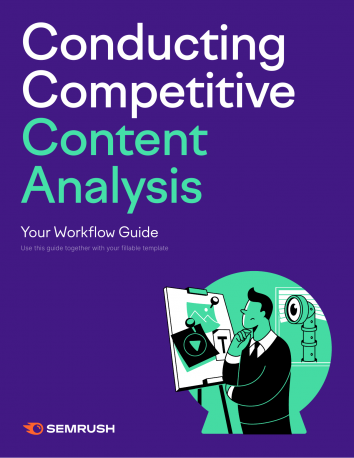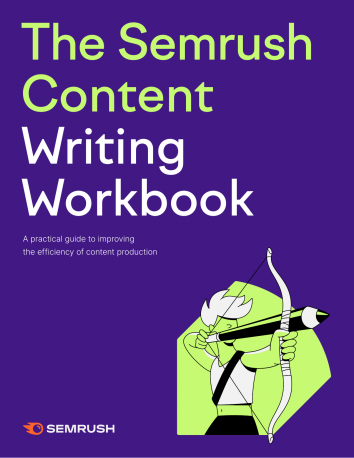Learn how to do Digital Marketing Competitor Analysis and beat your rivals in SEO and Google Ads, with their Backlink & Keywords info.
Figuring out the perfect digital marketing strategy for your business that has the best ROI can be a challenging task.
The process of identifying which channels are profitable for you, type of ads to run, or the best keywords to bid on can be time consuming and costly.
But… what if there was an easier option.
One that could save you months of work, and thousands of dollars in A/B testing.
Yes, we are referring to competitor analysis in digital marketing.
In this blog, we are taking a deep dive into how to conduct digital marketing competitor research covering key aspects like SEO competitive analysis, competitor keyword research, backlink analysis and peeking into competitor Google ads.
We will guide you through an effective set of 11 techniques, and show you exactly how to learn from your competitors and enhance your digital marketing strategies fast.
If you wish to find out what your competitors are doing to increase their sales, then let’s get started.
Digital Marketing Competitor Analysis Topics:
Please note that for this blog we will be using the SEMrush Competitive Research toolkit to show you how to conduct competitor analysis and find actionable data.
1. How to Identify Your “True” Competitors in Digital Marketing?
Before you take any step ahead, you need to first identify who your real competitors are.
I am referring to the domains that show up before you in Google search results. Businesses that rule in Google Ads and gobble up all the good converting traffic.
You might have a different set of competitors in the physical world, but in the digital space its an entirely different game.
In simple words, your competitors in the digital space are those who have the same target audience as you, and are promoting their business for a similar set of keywords or interests.
If you already have a list of digital competitors, we would still recommend you to go through the next steps so that you do not leave out any competitors.
In this section we will check out 3 ways to identify your competitors with SEMrush:
1.a. Find your Google Ad Competitors
By identifying these competitors you will find out what keywords are working in your niche on Google Ads, what ad copies they have used to get the most clicks and what landing pages they are using to increase sales.
To find out your ad competitors, login to SEMrush and head over to PPC Advertising Toolkit from the menu on the left select and select Advertising Research.
Type in your domain name (or your competitor’s) into the search bar and hit enter. Once the results show up, click on the third tab labeled ‘Competitors’ to get the list of domains you are competing with for the same set of keywords.
You will be able to see how many keywords your competitors are ranking for, how much traffic they are getting, and approximately how much they have spent on their ads in a month.
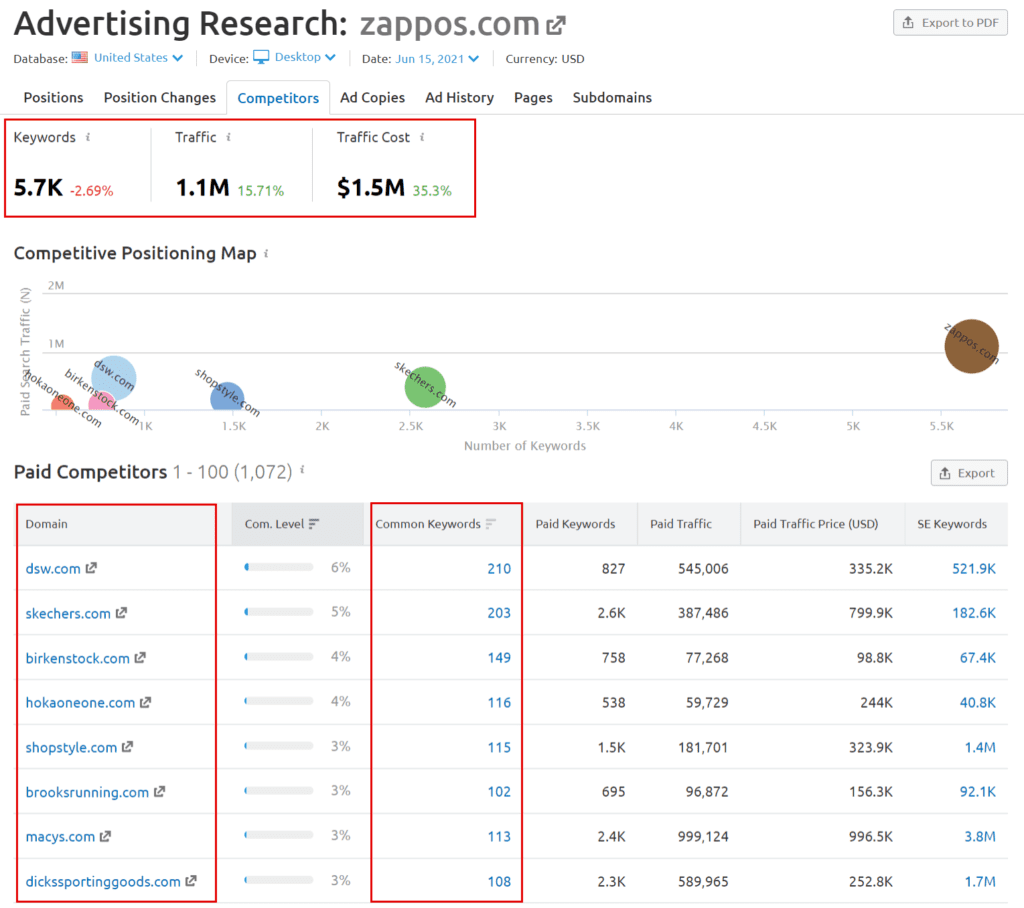
Points to note:
- At the very first line, you have details about Zappos.com, the number of keywords used in paid ads.
- Then you have information on the expected approximate traffic and estimated average monthly cost.
- After you have searched for your domain, click on the ‘Competitors’ tab right under Advertising Research.
- The Competitive Positioning Map tells you where the search brand stands in comparison to its competitors.
- Below the map, you have the list of the competitors based on the keywords used by Zappos.com
- Find out how your competitors are performing, their paid keywords, traffic and estimated cost.
- Most importantly you get to see the common keywords, on which you are competing on.
- If you are already logged in, you can directly access the Advertising Research Tool from here.
1.b. Find Organic Competitors
Organic Competitors refers to the brands or more specific domains that compete with you on organic Google Search results for the same set of keywords you wish to rank your website for.
If you have never done any Google Advertising for your domain then you can find your competitors with help of the Organic Research tool. This tool will help you flash out domains that are trying to rank for the same keywords as you on Google search results.
To identify your competitors for organic traffic, do the following:
- Use your login credential to access your SEMRush account.
- From the drop-down menu on the top left click on ‘SEO Toolkit’.
- Then click on ‘Organic Research’ from the vertical menu on the left.
- Type your domain name in the search bar and click Search.
- Select the option “Competitors” to get a list of the domains that are ranking for the same keywords as your brand.
- The websites ranking on the top of the search engine with your industry-relevant keywords will be your top rivals.
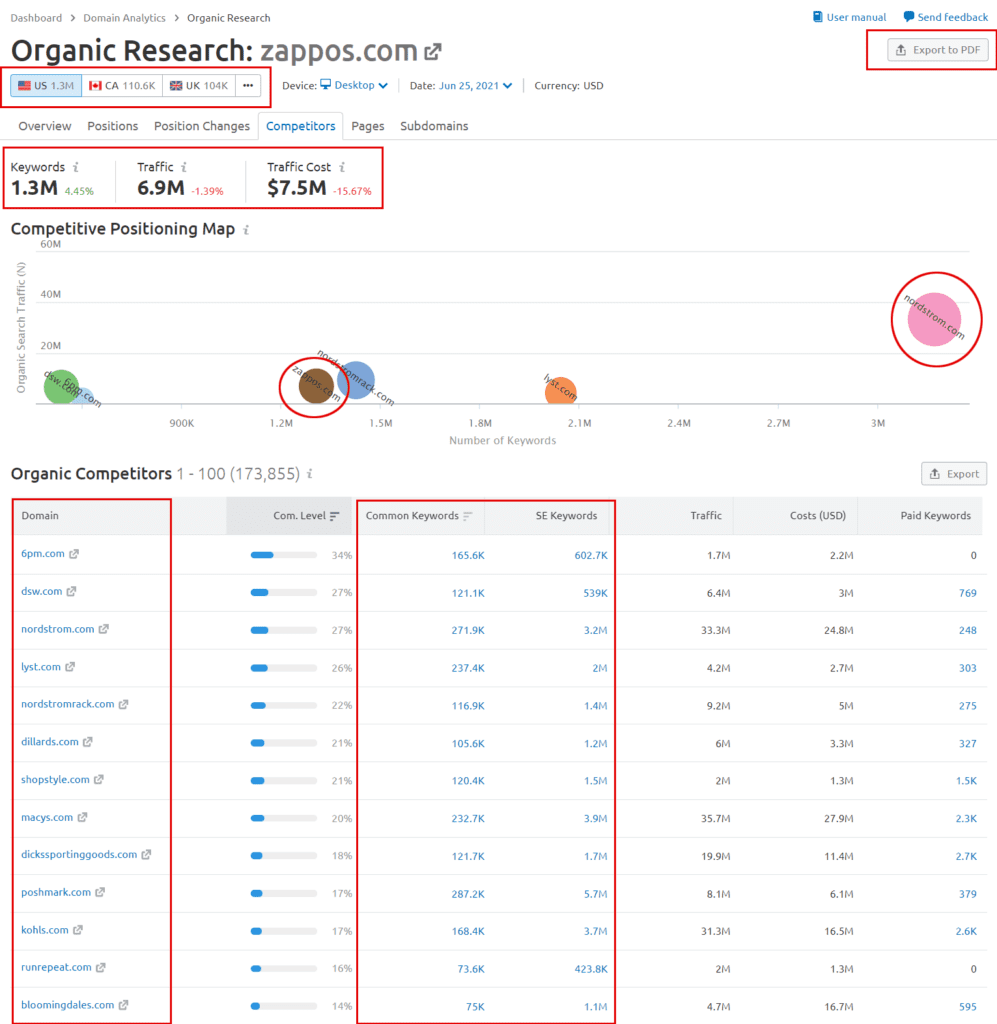
Points to note:
- From the top-left corner, you can select from which country you wish to check the results.
- You can export the report in PDF format to refer to it later or share it with your team.
- Then you have the organic traffic stats of Zappos.com – Keywords, estimated traffic and cost.
- On the Competitive Positioning Map, you would notice nordstrom.com is leading.
- On the table, you have the list of all your potential competitors and their details.
- Find out the common keywords, their traffic, cost and also paid keywords.
- Use this link to directly access the Organic Research Tool.
- Use the SEMrush Search box below to try out the tool and find crucial info about a domain.
Try it Free: Find your Organic Competitors
Let’s say you have built a travel and hotel booking eCommerce website. Now, if you type your domain name in the SEMRush search bar above and perform organic research for your competitors, the tool would return with the top travel and online hotel booking websites that are likely to compete with you for a similar set of keywords, such as booking.com or expedia.com etc. The tool displays each website according to its rankings. Domains will be ranked in an order based on the number of keywords they have in common with you.
The tool identifies competition according to the number of keywords two brands share. So, the list of the domains will feature the websites that share multiple keywords with your website.
1.c. Find Backlink Competitors
An extremely important feature of SEMrush, the Backlink Analytics tool helps you identify the sources from where you can get quality backlinks to beat your competitors. You will be able to uncover high authority domains that your competitors are getting backlinks from and replicate them to build a stronger backlink portfolio. Thus gain better SERP rankings, grow your traffic and as a result of it increase your revenue.
To identify your Backlink Competitors, do the following:
- Login to your SEMRush account.
- From the drop-down menu on the top left click on ‘SEO Toolkit’.
- Then under the ‘Link Building’ section click on ‘Backlink Analytics’.
- On the search box enter your domain name and click ‘Check It’.
- Once the results appear, select ‘Competitor’ from the tabs.
- This will show you all the domains that are likely competing with you for similar keywords and have a backlink profile that you can take advantage of.
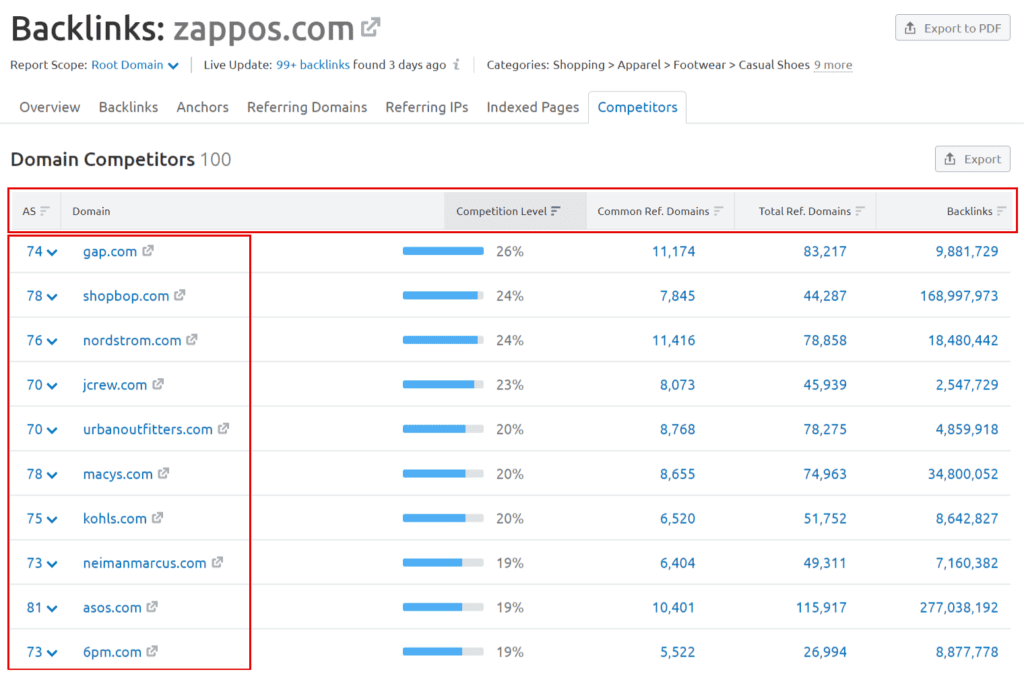
Points to note:
- In the Competitors tab, you will find the list of your backlink competitors.
- They are sorted by Authority Score marked by AS.
- You will be able to check the level of competition, common domains and total referring domains.
- Click on any of the blue numbers or domain names to view corresponding data.
- Click on total referring domains to find out all the domains that link to your competitors.
- You will be then able to sort those domains by their Authority Score.
- The Backlink Gap tool also shows the domains from which you have not got backlinks yet.
- You can directly jump to the Backlink Analytics Tool from here.
- Use the search box below to try out the Backlink Analytics tool.
Try it Free: Find your Backlink Competitors
When you have found your competitors, you can start working on them. If you go about trying to find such information manually it would take you a very long time and still you may not find a lot of valuable insights. The key benefit of such a tool is to get the right info fast, save time and grow faster.
Read more: Organic Competitor Analysis
2. Domain Overview: Analyze their Strengths and Weaknesses
Domain overview is another important competitor research tool that gives you insights into the full picture of a website’s online presence. This tool is used to get a quick overview of your competitors’ estimated organic and paid traffic, number of backlinks, number of keywords, display advertising, and other domain-related metrics.
From the Domain Overview, you can click on any data point and open up more detailed reports within SEMrush related to that data point to uncover more details and analyze the items further.
In short, you can enter your competitor’s domain name to analyze their strengths and weaknesses, to figure out how you can beat them. Find out where they shine – Ads or SEO and then find out what they are doing differently, learn from their tactics and beat them.

Hosts: Krista Tidman. Brandon Cooper. Stephen Stanczak
July 9, 2019
(Past Webinar – Recording Available)
Webinar: Competitive Analysis from an SEO’s Perspective
Learn how to find which Search Engine Features, Ads or SEO tactics your competitors are using to gain maximum exposure for your target keywords and how to systematically beat them.
Here’s how to use the Domain Overview tool:
- If you do not have it yet, get your Free SEMRush account.
- From the drop-down menu on the top left select ‘SEO Toolkit’
- Then click on ‘Domain Overview’ under ‘Competitive Research’ from the vertical menu.
- Type in the domain name in the search box.
- Then you can select the location from which you want to get the results.
- You can select a worldwide or a specific country.
- Click on ‘Search’ and uncover the insights.
- You can then click on any section to dive into the data.
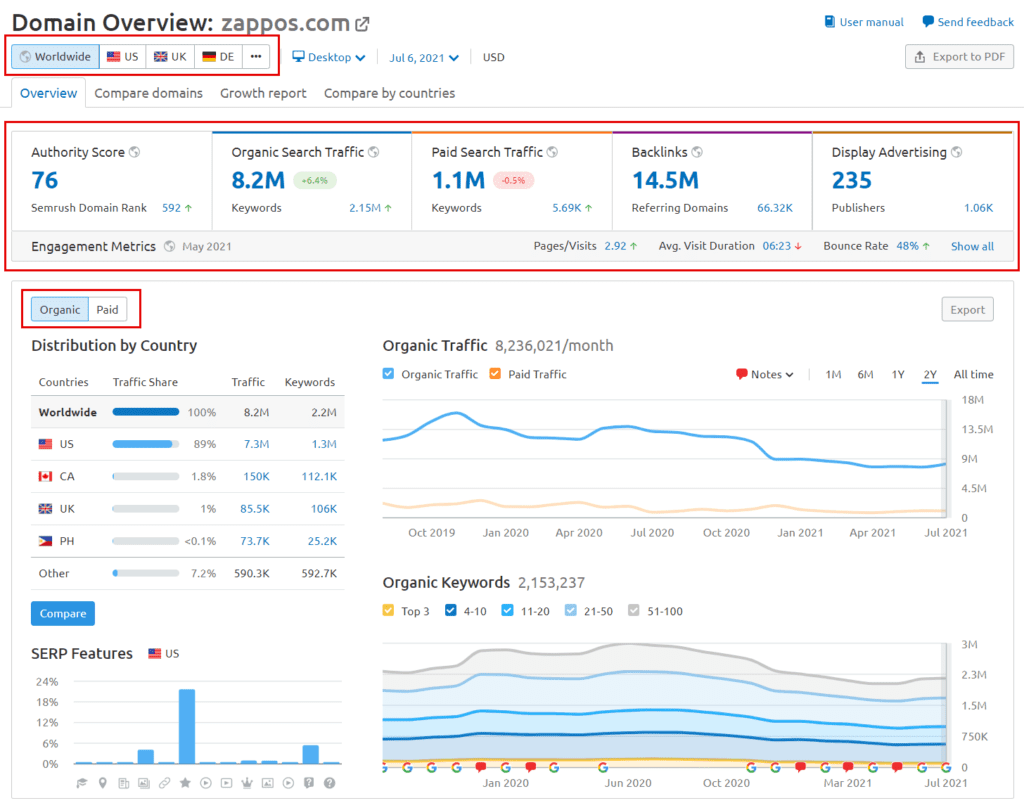
Points to note:
- As shown in the image above the first line gives you the option to gather data based on the country.
- In the second row marked with a box, you will find information about their Authority Score, traffic stats and a number of backlinks.
- You can then dice down the topic by selecting Organic or Paid
- Use this data to understand where a domain stands in terms of numbers.
- This is top-level data and you can choose to dive into finer details by clicking on any section.
- For example, you want to know how they have built such a strong backlink portfolio then click on the backlinks box and it will show you the list of backlinks that this domain posses.
- Then you can use the SEMrush backlink analysis tools to review and approach each referring domain.
Try it Free: Domain Overview Tool
Get a quick snapshot of your competitor’s traffic and create your plan of action to beat them.
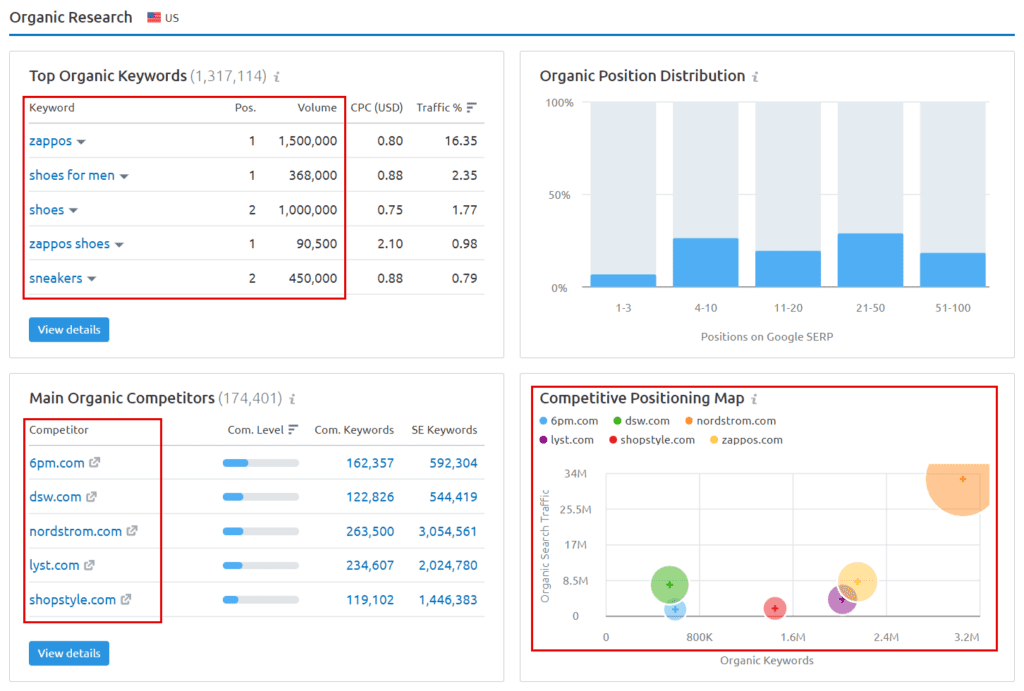
Points to note:
- As seen in the above screenshot you can uncover the top-performing keywords of your competitors and then if suitable you can use those keywords to increase your traffic.
- You also get to see the Organic Competitors (SEO Competitors) of the domain you are analyzing.
- And then on the third box marked in red, you get a visual representation of the competitive landscape.
- With help of the Competitive Positioning Map, you can visually analyze how your domain fairs against your competitors and learn from the ones that are better positioned than you.
- You can also take this representation to a next level and analyze the competitors of your competitors, thus increasing your scope and collecting valuable data to dominate your niche market.
You will find a plethora of metrics that present a detailed report on your competitors’ domain performance. You could also use the tool to run competitors’ keyword research. It helps you find the highest-ranking keywords of the domain and keywords used for PPC advertising campaigns. We highly recommend you use the Domain Overview tool to get every piece of information you need about your competitors. In this section, you will find different modules that help you assess the strength and weaknesses of your top competitors.
The tool allows you to compare up to 5 competitors at a time. You can also compare your domain authority with your competitors.
Download Free: Competitor Analysis eBooks
4 Additional ways you can use the Domain Overview Tool:
- If you are planning to partner with a website for a promotion and you want to analyze if they have enough strength to make your joint venture campaign successful you can use this tool to get a quick overview and then drill down into specific reports for more details.
- If you are a marketing agency, you can use it to analyze the domain of your prospective customer and see what their current standing is and what they are lacking in, so that you can suggest exactly what can improve their online presence. You can uncover how much-estimated traffic they are receiving and what their backlink profile looks like so that based on that you can estimate how much work might be required on their website.
- Say you are planning to advertise on a website and you want to know if they are worth the money you are about to pay them. Find out where they get their backlinks from so that your website does not get negatively impacted by their backlink profile.
- You can use this tool for a quarterly or monthly analysis of your own domain. Analyze if you have been progressing or fallen back as a result of the digital marketing activities you have implemented in the past quarter or month. See where you have progressed well and what may still need improvements so that you can plan on where to invest your resources next.
3. Traffic Analytics: Dive into Competitor’s Traffic Stats
Now if you want to dive deeper into your competitor’s traffic information and find key insights – you’ve got the Traffic Analytics tool. The Traffic Analytics tool to helps you analyze the nature and performance of your competitor’s traffic and provide you with information that will be impossible to uncover without a smart tool. Find out their sources of traffic, bounce rate, customer engagement, unique visitors, the average duration of each visit, the average number of pages per visitor, and more such metrics.
To perform Traffic Analysis of your competitors, do the following:
- Login to your SEMRush account.
- If you do not have an account yet, get a trial SEMrush account here.
- From the drop-down menu on the top left click on ‘SEO Toolkit’.
- Then click on ‘Traffic Analytics’ under the ‘Competitive Research’ section from the vertical menu on the left.
- On the page that appears you have a couple of options to choose from in the drop-down menu:
- Check Competitors: Enter your competitor’s domain name to find out about their traffic stats.
- Compare Domains: Select this option to compare the traffic stats for 2 domains. You can enter your domain anime in the first box and your competitor’s in the second to perform a side by side comparison of traffic on both websites. You get to see where your domain is missing out on and in what ways your competitor is doing better. It could be in terms of the number of visitors or the level of engagement on the website.
- Analyze in bulk: Using this option you can perform a side by side comparison of the traffic stats of up to 200 domains. You can uncover their secrets and find out how you can outdo them.
- Once you have made your selection, type in the right domains and hit ‘Search’.
The tool will return with important metrics to give you a better understanding of the most common traffic sources for your competitors. You can sort the traffic research by traffic overview, traffic sources, geo-distribution, subdomains, and destination sites.

Points to note:
- You can start your search with a root domain and compare up to 5 competitors side-by-side
- When you search for a single domain the tool shows you their traffic stats and performance in terms of pages/visits, Avg. Visit Duration and bounce rate etc.
- The next marked box shows that option you can use to see traffic trends by the device based on specific engagement parameters.
- You can also select different date ranges as per your requirement, 6 months, 12 months or all time.
- Use these options to determine how your competitors’ websites are performing on different devices.
- If you are logged in you can directly click on the Traffic Analytics Tool.
Read more: Analyze Competitor Traffic

Points to note:
- As seen in the above screenshot you can use the Traffic Analytics tool to find out the top pages for your competitor.
- Find the percentage of traffic based on the source so that you can understand which channels you need to focus on.
- The table on the bottom-right corner shows how much traffic they get from each source.
- This gives you an idea of the scale of traffic the competitor receives from each channel so you would know how much effort might be required on your part to beat them.

Points to note:
- This is a very interesting visual representation of all your competitors created by the SEMrush AI engine.
- The Growth Quadrant takes your top competitors and shows where they stand based on their market performance.
- On the right side, you have the list of domains
If you choose geo-distribution, the tool will present to you the list of countries your competitors are driving traffic from. These valuable insights will help you identify the top traffic sources of your competitors, how they are engaging their visitors, and how they are building up their revenue.

Hosts: Tristam Jarman. Aaron Dicks
Dec 1, 2020
(Past Webinar – Recording Available)
Webinar: How to Use Competitor Analysis for Your Marketing Strategy
Find out how you can use competitive intelligence data to advance your marketing strategies with a holistic approach and stay ahead of your competitors.
Join Aaron Dicks, Managing Director of Impression, as he shows how to uncover your rival’s acquisition strategies.
As we go ahead, with each section we will be checking a new option to uncover your competitor’s strategy. So please do go through the entire blog and in case you have any questions please feel free to Contact Us.
4. Competitor Keyword Research: Find Valuable Missing Keywords
With the Keyword Gap analysis, you will be able to find out keywords that your competitors rank for but you do not. If you are not ranking well in the search engine results and not getting enough traffic, chances are you are missing out on some important keywords. The SEMrush Keyword Gap tool helps you compare the keywords of up to 5 competitor domains in one go and acquire valuable insights. You can check and compare their Paid Ad keywords, Product Listing Ad keywords, and organic (SEO) keywords.
When you are able to identify the keywords that are working for your competitors, you can optimize your content for the same and increase your traffic. You would know where to focus your efforts and increase your revenue. You do not have to break your back figuring out the right set of keywords, you just need to find the ones that are already working in your target market.
Here’s how you would perform Keyword Gap Analysis:
- Log in to your SEMRush account
- If you do not have an account yet, you can get a trial account from here.
- Select ‘Advertising Toolkit’ from the drop-down menu on the top left
- Then click on “Keyword Gap” under the “Keyword Research” section menu on the left and type the domains of your top five competitors.
- The tool allows you to choose from Product Listing Ad keywords, Organic Keywords, and Paid keywords. So, now you can select the type of research you would like to conduct on your competitor’s keywords.
- Alternatively, you can directly access the Keyword Gap tool using this link.
The SEMrush Keyword Gap tool will then display all the top-performing keywords based on total keyword overlap, common keywords shared by all sites and lots more.
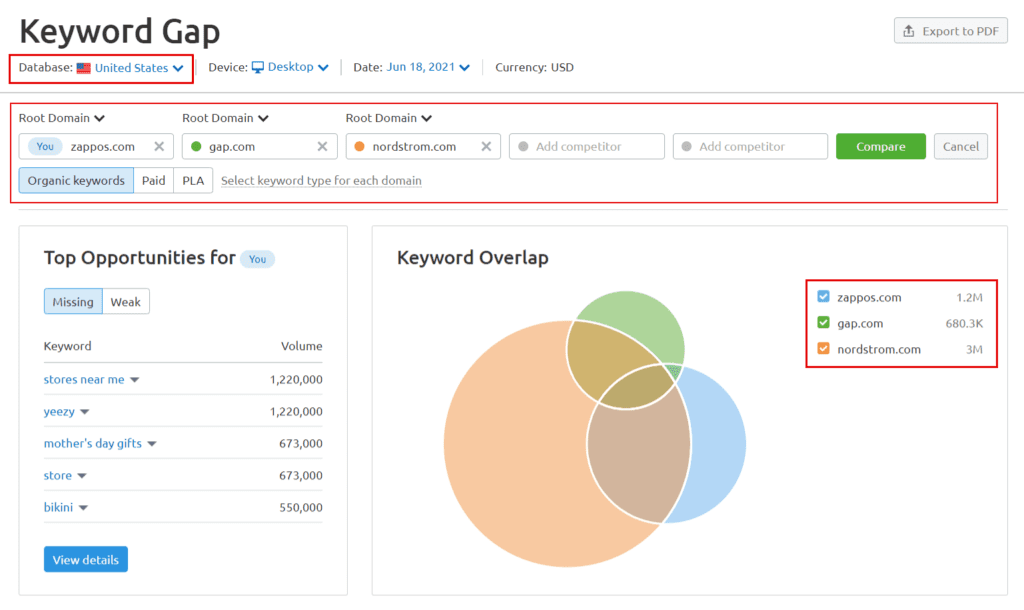
Points to note:
- As seen on the screenshot you have the option to select from which country you want to get the keyword performance data.
- In the next row enter the root domains for which the keywords need to be analyzed and compared.
- Once you hit search, the tool shows a Keyword Overlap map that tells you what common keywords you are already competing on and how many new keyword opportunities you can explore.
Read more: Essential Keyword Research Tactics

Points to note:
- Use the first marked tabs to select the type of keywords you want to view. Missing and Untapped keywords would be valuable to examine and incorporate in your keyword mix.
- In the table, you have the list of keywords. In columns, you have SERP ranking of each domain for respective keywords, followed by keyword volume, difficulty, bid cost for PPC etc.
- Access the Keyword Gap tool to analyze your competitors and find out how you can beat them.
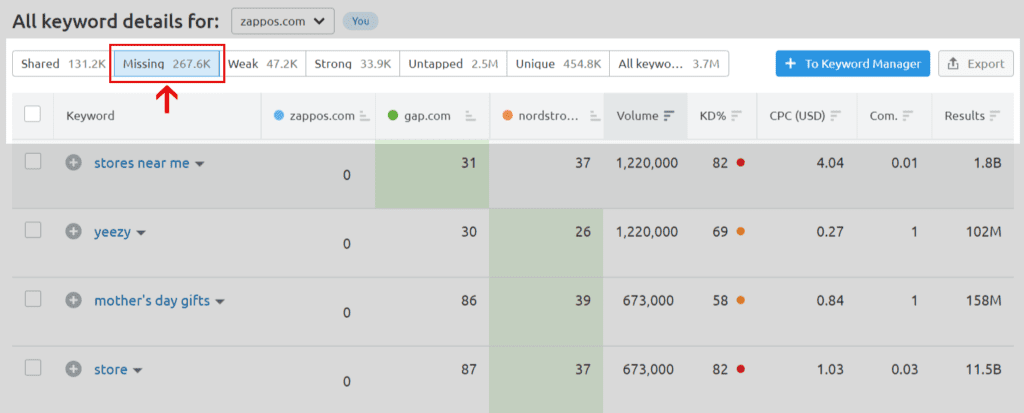
Points to note:
- As shown in the screenshot image you can use the tabs in the marked row to analyze your keyword mix in comparison to your competitors.
- Click on the Missing tab to find out the keywords that you are missing out on.
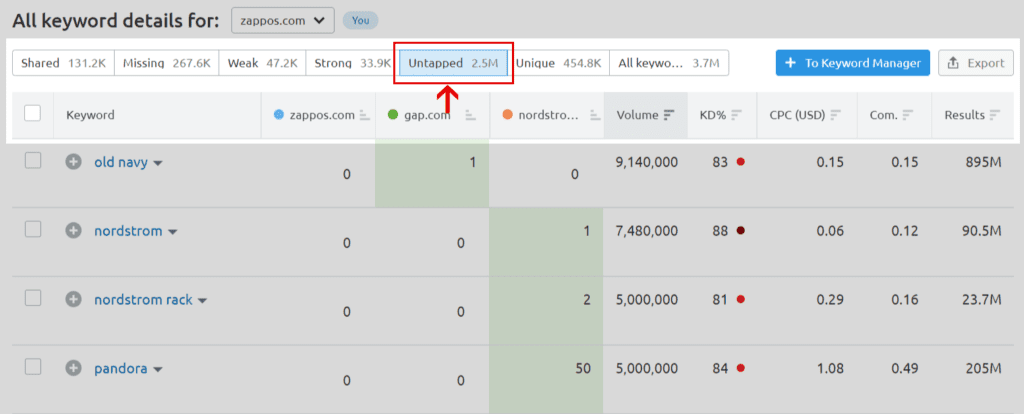
Points to note:
- Click on the Untapped tab to find out the keywords that no one has used yet and has great potential.
- While selecting the keywords to incorporate into your strategy make sure you are considering the Keyword Difficulty (KD%), Cost and Competition level. A keyword with moderate volume but low KD% or Competition may provide you better results.
Try it Free: Check your Competitor Keywords
Having the right set of keywords in your SEO and PPC plan can provide you a significant competitive advantage. Find out how your keywords fair against your top competitors and upgrade your keyword mix to increase traffic to your website and get better ROI.
With help of this data you can identify unique keywords that your competitors are ranking for but you are not. You also get visual charts presenting the keywords overlap of each website that helps you perform competitor analysis of the keyword sets that you are missing out on.
5. Competitor Backlink Analysis: Find Gaps and New Opportunities
One of the most challenging yet important parts of an SEO strategy is creating a strong backlink portfolio. You can’t outperform your competition without an effective link building strategy in place. So, if you are wondering where to start, and how to build a rewarding backlink structure then you are going to love what we are about to discuss.
These backlink tools make link building a whole lot easier and more effective, the emphasis being on effectiveness because it’s not enough to just have any backlinks. Google algorithms have gotten a lot smarter and they no longer care about just numbers, they want quality backlinks. You could have just 100 backlinks but if these are really solid ones from reputed websites in a related niche then they are going to have a much higher impact on your search rankings.
That’s what we are going to work out here – How to find high-quality relevant backlink opportunities to increase SERP rankings and strongly hold top positions.
Competitor Backlink Analysis Tool
You can use the SEMrush Backlink Analytics tool to gather information about your competitor’s backlink profile, and yours as well. The tools show where they are getting quality backlinks from and the backlink properties. It shows you untapped backlink opportunities where you can actually focus your efforts and save a lot of your valuable time. With this tool, you can save costs in man-hours and be able to gain rankings much faster.
Using the backlink analysis data you can form a monthly or quarterly link building strategy to increase your backlink portfolio. The Backlink Analytics tool also includes a neat feature to mark the backlinks you want to pursue and keep a record of your link building process.
Here’s how you can use the Backlink Analytics tools:
- Log in to your SEMRush account
- Select ‘SEO Toolkit’ from the drop-down menu on the top left
- Then click on “Backlink Analytics” under the “Link Building” section menu on the left and type in your domain name.
- And click on ‘Check it’ to initiate the search process.
- This tool will at first show you data about your own backlink structure.
- Click on the ‘Competitors’ tab to find out which domains are competing with you for the same set of keywords.
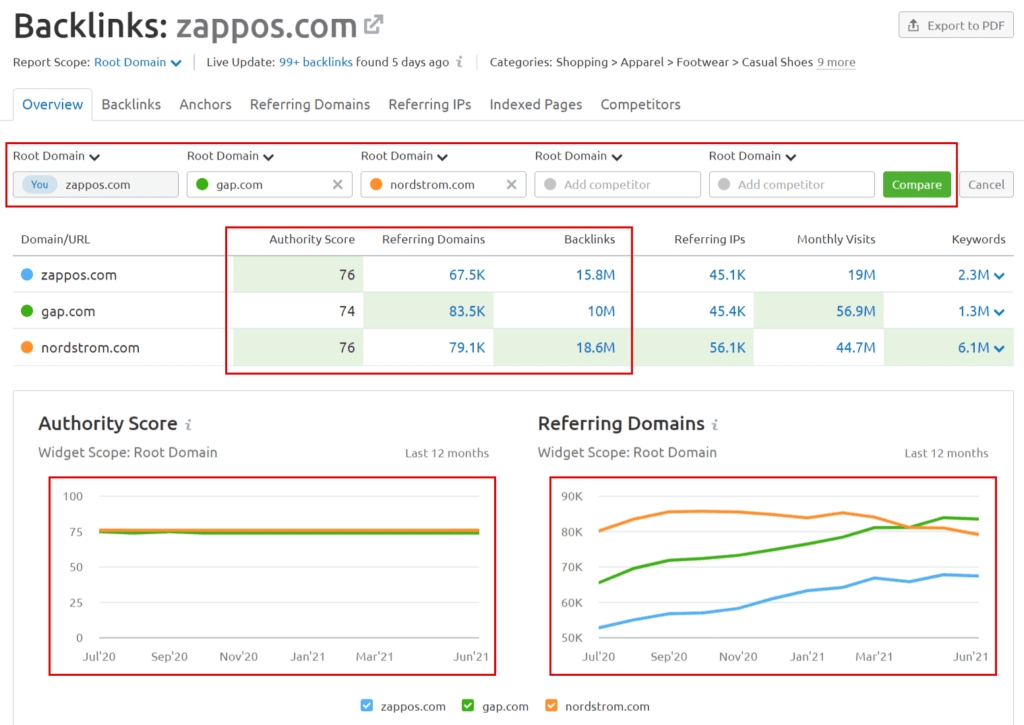
Points to note:
- On the Backlink Analytics tool, you can either search with one domain or simultaneously search for up to 5 domains and analyze their stats side by side.
- In the above example, we are comparing the backlink stats of zappos.com, gap.com and nordstrom.com
- On the first table you see the Authority Score, no. of Referring Domains and no. of backlinks along with a few other stats for each domain.
- The graphs show changes in Authority Score and no. of Referring Domains over time.
- If you are logged in, you can directly access the Backlink Analytics tool.

Clarify Doubts: Request a Personalized Demo
Get an expert from SEMrush to show you how you can extract valuable information specific to your business. Learn how to achieve you marketing goals and improve sales. Clear your doubts and create a plan take action on.
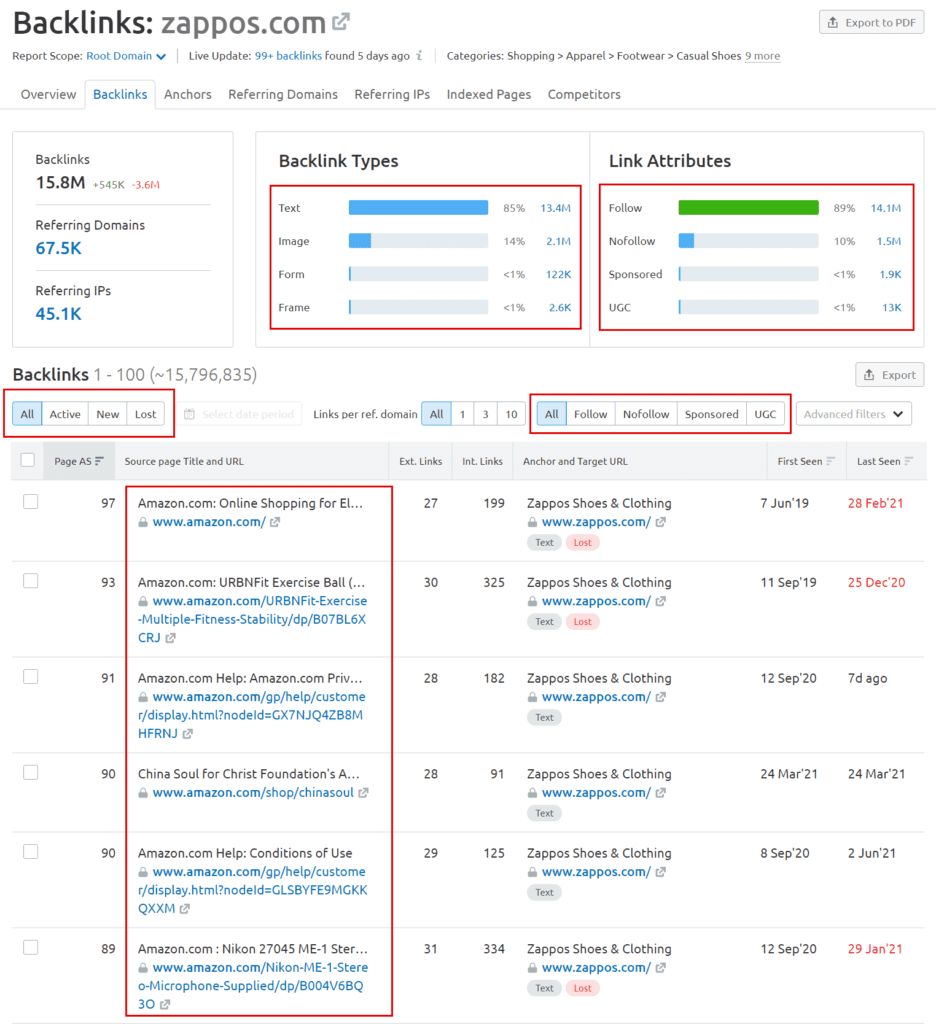
Points to note:
- On the very first row, you have the Backlink Types and Backlink Attributes.
- Then the table shows sources from which a domain is receiving backlinks.
- You can do this search for your own domain or for your competitor’s domain and find valuable insights.
- You may also filter the backlink list based on its status (Active or Lost) and property (Follow or Nofollow)
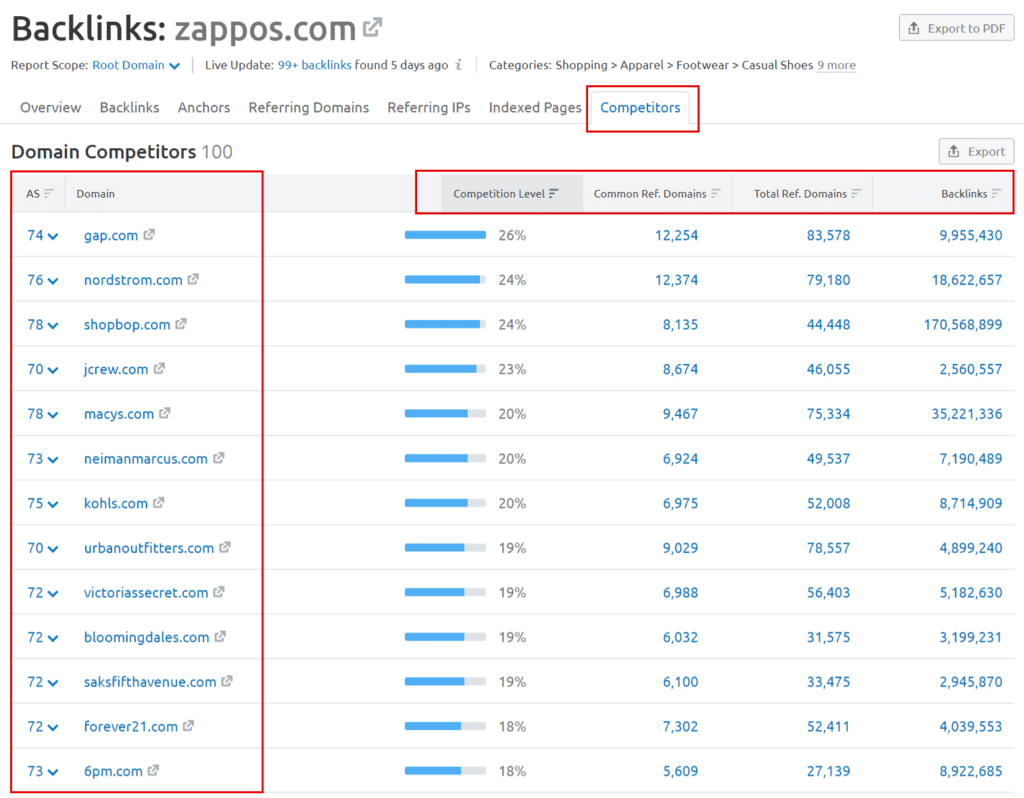
Points to note:
- Click on the last tab named ‘Competitors’ to get the list of organic competitors of the searched domain.
- View competition level, common referring domains and total referring domains for each competitor.
- Use this data to understand the backlink strength of your competitors and adapt your SEO strategy accordingly.
- You can also find and reach out to high authority domains that link to your competitor’s website.
Read more: Competitor Backlink Analysis
Competitor Backlink Gap Analysis Tool
The Backlink Gap tool helps you identify high authority domains from which your competitors are getting backlinks but your website is not. Based on this information, you can optimize the backlink profile for your website to push it ahead in the search results. The Backlink Gap tool allows you to analyze up to 5 competitors side by side.
This is how you can perform the Backlink Gap analysis:
- Log in to your SEMRush account
- Select ‘SEO Toolkit’ from the drop-down menu on the top left
- Then click on “Backlink Gap” under the “Competitive Research” section menu on the left.
- This will show a page with 5 boxes to enter domain names for backlink gap analysis. In the first box enter your domain name and then in the remaining four boxes enter the domain names of your competitors.
- Then click on ‘Find Prospects’ to initiate the search process.
- This will return with a detailed report of which high-quality websites are linking to your competitors but not to your domain.
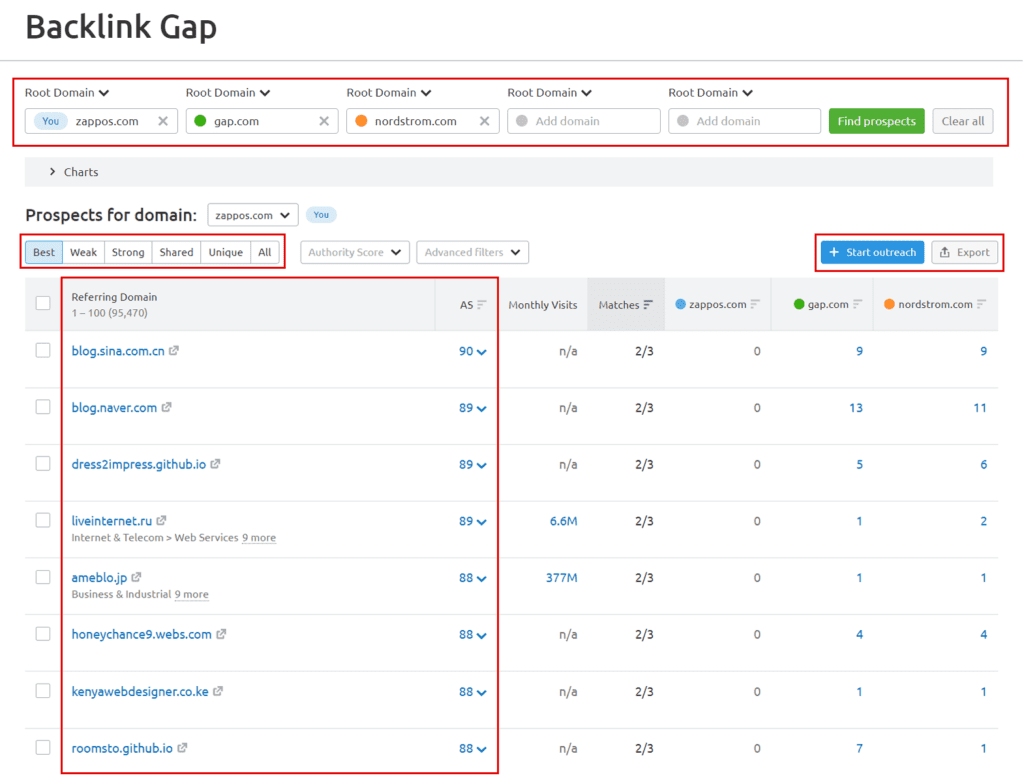
Points to note:
- In the first row marked in the screenshot above, you can find the backlinks you are missing when compared to up to 4 domains.
- The table below that shows the root domains from which you have no backlinks along with data related to the. of monthly visits and how many links each of your competitors receive from those domains.
- Also note that you can categorize the backlink root domains based on parameters like Best Match, Weak, Strong, Shared, Unique and All.
- Use this tool to identify the high-quality domains from which you have not received a backlink, mark them and start the outreach activity.
- You can check the box in front of a domain and then click on ‘+ Start Outreach’ to send the links to the outreach management feature within SEMrush, which makes your work easy by eliminating the need to maintain multiple spreadsheets.
- If you are logged in, use this link to access the Backlink Gap Analysis tool.

Free Course . 7 lessons. 1 hour
Free Course: Backlink Management Course with Greg Gifford
Vice President of Search at SearchLab Chicago, Greg is an SEO consultant with over 17 years of experience, specializing in local SEO. He has been an honoured speaker at top SEO conferences across the world.
Pick up key skills from a leading SEO expert.
You can use both tools to get different types of data. The Backlink Analytics tool gives you an in-depth analysis of a single domain or a set of domains. It could be your domain or your competitors’, but then you can click on the ‘Competitors’ tab to identify the domains competing with the domain in search. With help of this tool, you would be able to identify your backlink competitors and the competitors of your competition.
The Backlink Gap tool helps you compare the backlink profile of up to 5 websites side by side. It helps you see which high-quality domains are linking to your competitors but not to your website.
Pro tip: Competitive Backlink Analysis
If you want to get an overview of the backlink opportunities you have not utilized, then you must add your domain to the first box of the Backlink Gap tool search. This means you have to enter your domain followed by domains of your top 4 competitors.
Being able to acquire the data about where your competitors are getting their most valuable backlinks from gives you an upper hand. You know where you need to focus your efforts if you wish to beat your competition in organic search. You need not spend hours in research to identify the best domains to get backlinks, the data is right in front of you in minutes. All you need to do is build the backlinks and you are all set.
What’s more important is that you will save cost in billed work-hours as your team would be able to find backlink opportunities faster and invest more time in building backlinks rather than finding them. This means you will be able to get more work done within a given time frame. Build backlinks faster, improve rankings and get more traffic to your website.
6. Topic Research: Take your Content Marketing to the Next Level
Use the SEMrush Topic Research tool to dive into your competitor’s content based on a keyword you wish to target. Learn from their most successful content themes to create engaging content and improve your SEO rankings. You can use the Topic Research tool in 2 distinct ways:
- Competitor based: Research content ideas from competitor’s website based on a keyword.
- Top Websites: Get content ideas based on top websites in Google search results for a keyword.

To get content ideas from a competitor’s website, click on the ‘+ Enter domain’ link as marked in the above image and type in your competitor’s domain name. Then put in the keyword you want to get ideas for, select the country and hit enter. This will bring you content ideas for your keyword only from the mentioned domain.
Whenever you find yourself struggling to find fresh and relevant content ideas that have good search volume use either of the approaches to find interesting content to write about. If you are not certain about the topic ideas, then take a look at your competitors’ topics and create better content.
Topic Research Tool for Competitive Content Marketing
You only have to mention the topic or the long-tail keyword in the SEMRush search bar. For topic research do the following:
- Login to your SEMRush account.
- From the drop-down menu on the top left select ‘Content Marketing Toolkit’
- Then click on ‘Topic Research’ from the vertical menu on the left.
- Type in your topic in the search bar and then select the country and region from where you wish to see the results.
- You can also select the language in which you wish to get the results in.
- Now click on the ‘Get Content Ideas’ button to run the search and view the results.
- Go to the ‘Cards’ section, and check the green cards – these are the topics covered by your competitors that rank in the top 100 Google results.
- You can add headlines and questions to your favourites so that you can get back to them at a later stage.

Points to note:
- Once you search with a keyword you are shown the results as seen on the screenshot above.
- Content ideas are categorized into cards based on their theme for easier reference and management.
- From the top, you can change the keyword and the country to get results from a different location.
- Toggle display format from 4 options: Cards, Explorer, Overview or Mind Map; based on what you like.
- You can choose to dive into a specific topic theme by clicking on the ‘Show More’ link at the bottom of a card.
- Once you click on ‘Show More’ you will see something like the following screenshot.
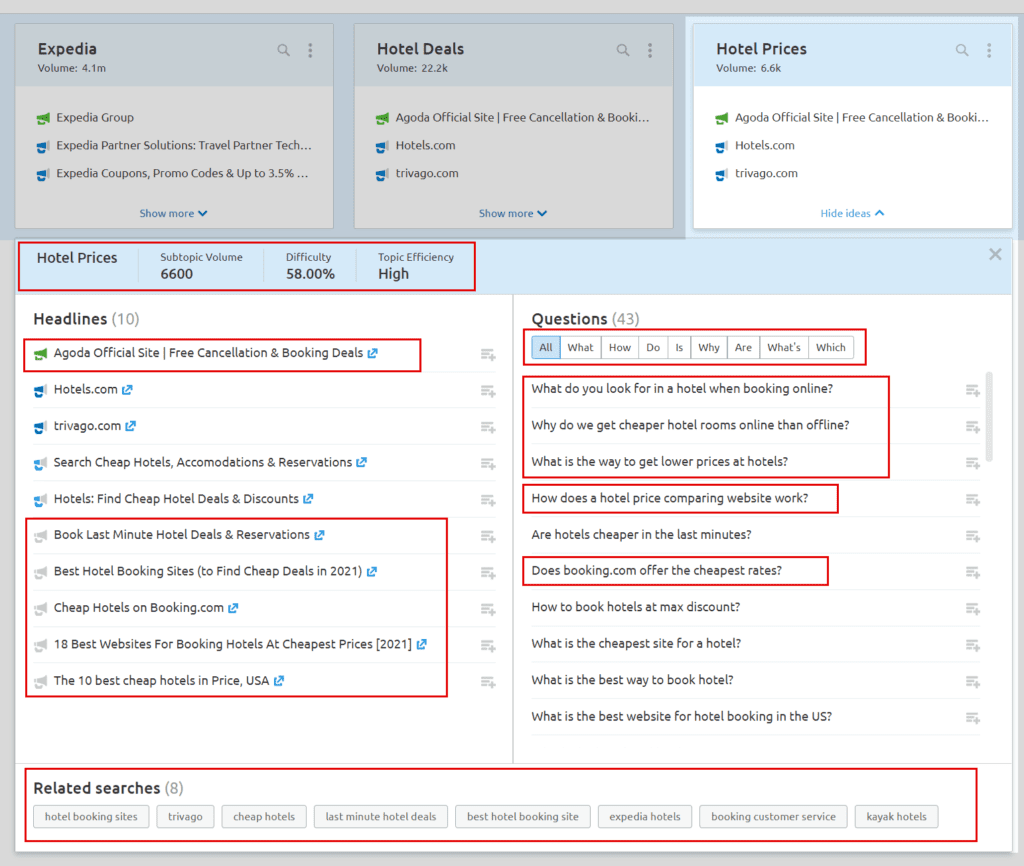
Points to note:
- When you click on ‘Show More’, SEMrush will present you with a list of subtopics that you can choose from.
- On the left, you have headlines of the website from the top 10 search results for that subtopic.
- On the right, you are shown a list of questions that you can treat as headings/sections for your content.
- The questions on the right are categorized as ‘All, What, How’ etc. to help you form the right style of content.
- Use the ‘Related Searches’ to expand your content discovery exercise and gather more ideas.

Points to note:
- The above screenshot shows how clicking on ‘What’ updates the questions in the list.
- Use this option to align your content blocks with your objective.
The Topic Research tool helps you determine the most popular topics and content sections for your keywords. The tool can be used to generate some exciting topic ideas for your next post and used to outperform your competitors by creating content that performs better in search results.
Pro tip: Content Topic Selection & Usage
1. Determining best content: Choose topics that have moderate to high search volume but low difficulty. This means the topic is popular among your target audience but it has low competition. When you click on ‘Show More’ on any card you will find the search volume and difficulty related to that topic.
2. Create an FAQ page: Use the Topic Research tool to find the frequently asked questions in your niche and build a FAQ page answering those questions. A FAQ page can help you gain Featured Snippet and improve the SEO rankings of your website. It also helps you to establish yourself as a thought leader.
3. Identify location-specific issues: Use the tool to view questions from your country of operation to understand the concerns of people in a specific region. Then create content or update your service details to cater to some of these requirements.
SEO Content Template to beat your Competitors
If you can start your content knowing what’s required to make it SEO-friendly for your target keyword then it can save you a lot of trouble. SEO Content Template tells you what your content must include so that your content is ready to rank well on SERP. Use this tool to make your content effective from the start.
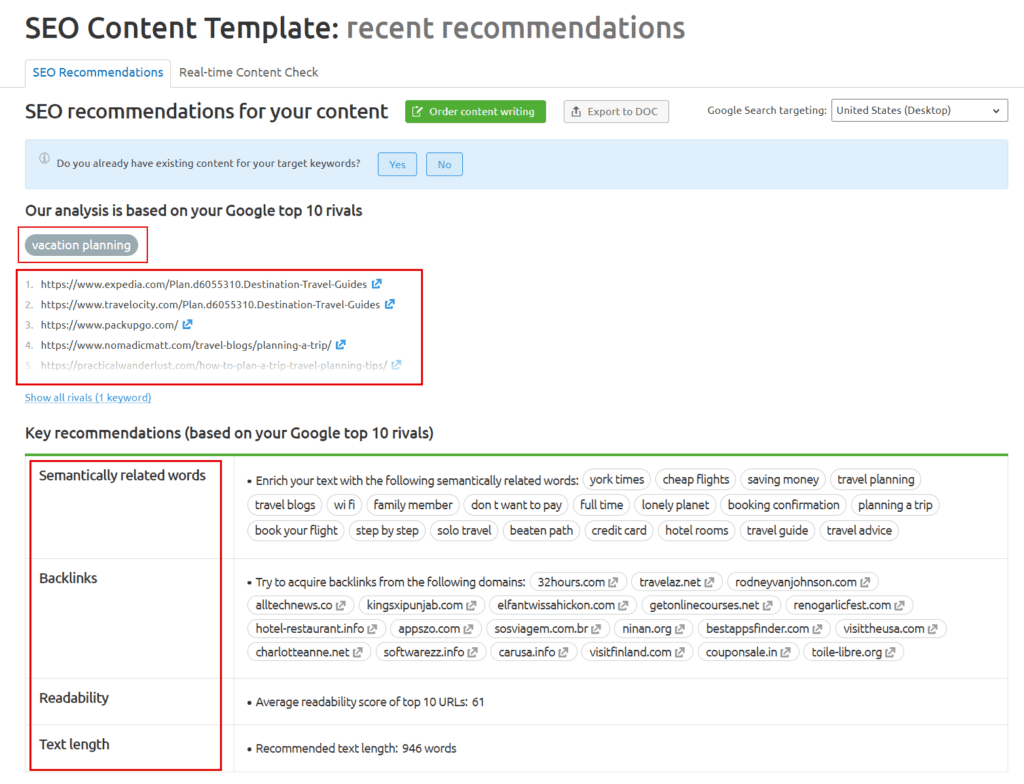
Points to note:
- We searched for the term ‘Vacation Planning’ and the tool brought up suggestions based on the top-performing pages in the search result.
- You will find out the ‘Semantically related words, which are used by Google to estimate relevancy of a content piece for a search term.
- Then the tool shows you from which websites you can acquire backlinks.
- You also get an Average Readability Score for the top 10 results so that you can create something better and increase your chances of ranking higher.
- You are also shown the recommended text length so that you know what to aim for.

Points to note:
- In the next section, you are shown how your competitors have created content for that keyword.
- The tool even highlights wherever the searched word appears so that you can get ideas about how to insert the keywords.
- You also get an idea of which titles and what type of content are performing the best.
- In the screenshot above we can see that content related to trip planner apps is also ranking well, proving how you can diversify your content approach and giving you new ideas to write with.
Download Free: Content Marketing eBooks
On the other hand, if you are thinking about Guest Blogging and posting content on other websites to build genuine backlinks then it will help you a lot to have good quality content on topics that are in demand. Usually, blog editors would have to perform a lot of research and put in the time and effort to build engaging content, so if you approach them with such in-demand quality content then there is a high possibility that the editors will not hesitate to accept your content for posting.
7. Competitor Ads Analysis: Ad Copies, Keywords and Landing Pages
If you want to find out what keywords your top competitors are using, or what their ads and landing pages look like, then this is the right tool for you. If you are interested in competitor keyword research, then you will love what we are about to show you.
The SEMrush Advertising Research is divided into 2 parts: Search Ads Research and Display Ads Research (banner and HTML Ads). In this section, we will focus on Search Ads and find out how you can uncover your competitors’ keywords, ad copies and landing pages. We will look into Display Ads Research in the next section.
Google Search Ads Competitor Analysis Tool
The Search Ads analysis tool gives you a detailed report of your competitors’ text ads, the keywords they use in their advertising campaigns, the ad copies that are working for them and the landing pages they target with those ads. You can then open up the landing pages for each ad and find out how they are trying to entice their visitors and generate engagement or leads. You would also be able to uncover if your competitors are using different versions of ads and landing pages for a given campaign.
With the Advertising Research data you can analyze the following:
- Keywords: Identify keywords that are driving results for your competitors and use them in your campaign. Lower advertising costs, gain higher positions on SERP and send more traffic to your website.
- Ad Copies: Find out which ads are able to grab the attention of your target audience and do something similar. See if your competitors are using any unique or brand keywords in their ads.
- Landing Pages: Find out if your competitors are doing something different on their landing pages to entice their visitors. What are they doing to generate leads, do they offer a free sample, what Discount Offers or Seasonal Promotions are they running on their website.
Armed with this competitive intelligence you will be able to take your brand ahead in Google Search Ads.
Here’s how you can perform Advertising Competitor analysis:
- Login to your SEMRush account.
- If you do not have an account yet, get a trial SEMrush account here.
- From the drop-down menu on the top left select ‘Advertising Toolkit’
- Then click on ‘Advertising Research’ from the vertical menu on the left.
- Type the domain name of your competitor in the search bar and click ‘Search’.
- The results show full advertising details of your competitors, their ad positions on search results, how much they are bidding on those ads, the actual text ad copies, top-performing keywords and the associated landing pages.
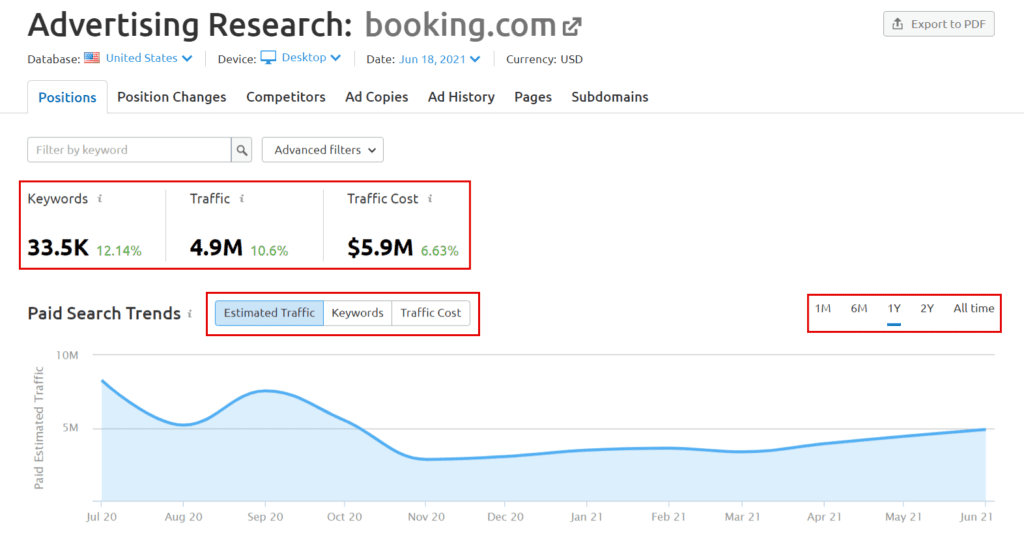
Points to note:
- Once you search with your competitor’s domain name, you will see their estimated paid traffic stats: Keywords, Traffic and Cost.
- Then with the help of the graph, you will be able to see how their paid traffic trend has been.
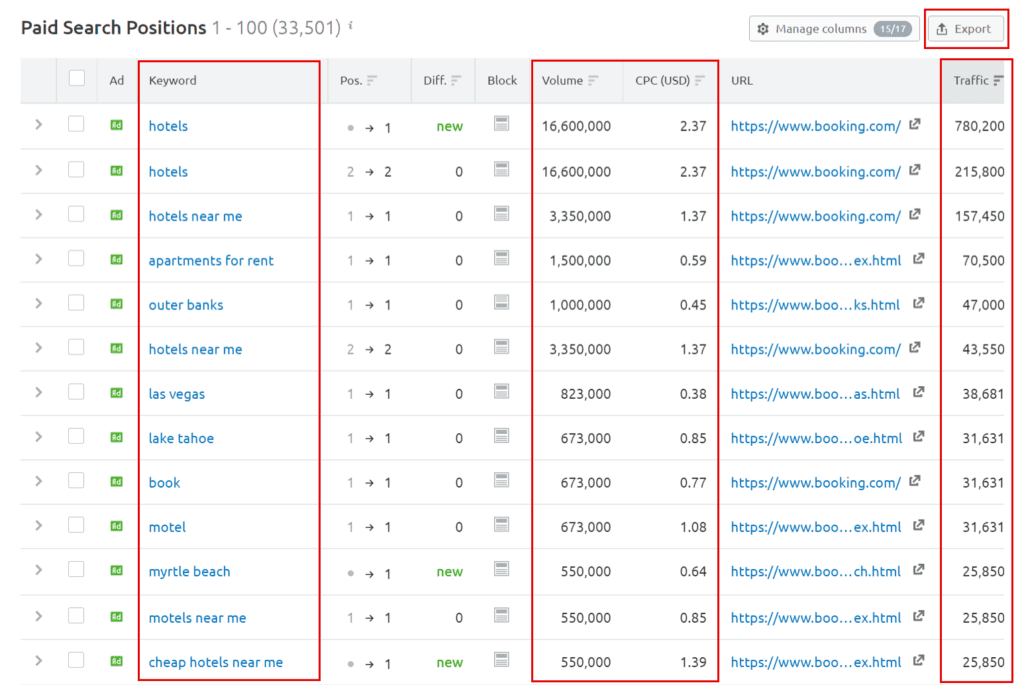
Points to note:
- Right below that you will find the list of keywords along with a lot of valuable data points.
- You will be able to find out the volume, cost and traffic brought in by each keyword that your competitor has invested in.
- View URLs associated with each keyword so that you can understand how your competitors are aligning their products against each keyword.
- Note that you can sort the results by any column and also export the data for reference or to work on with your team.
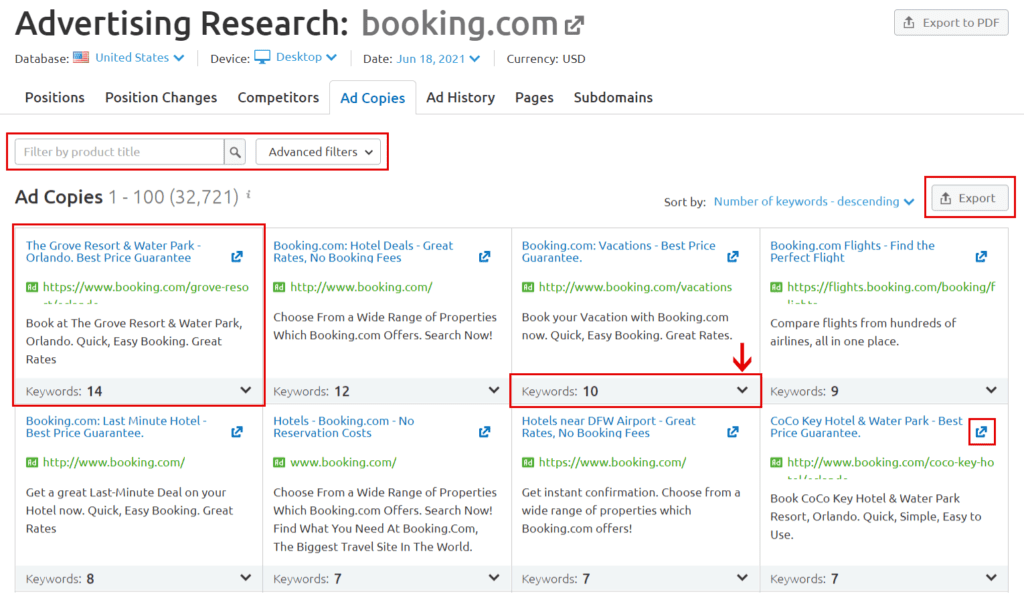
Points to note:
- On of the most interesting features of SEMrush is you are able to view your competitor’s ads as well.
- You get to watch and learn from their ad copies – headings, description and keyword usage.
- When you click on the outbound arrow beside the title it opens up the landing page.
- To view the keywords associated with each ad click on the downward arrow.
- You can learn from their Google Ads strategy and optimize yours to perform better.
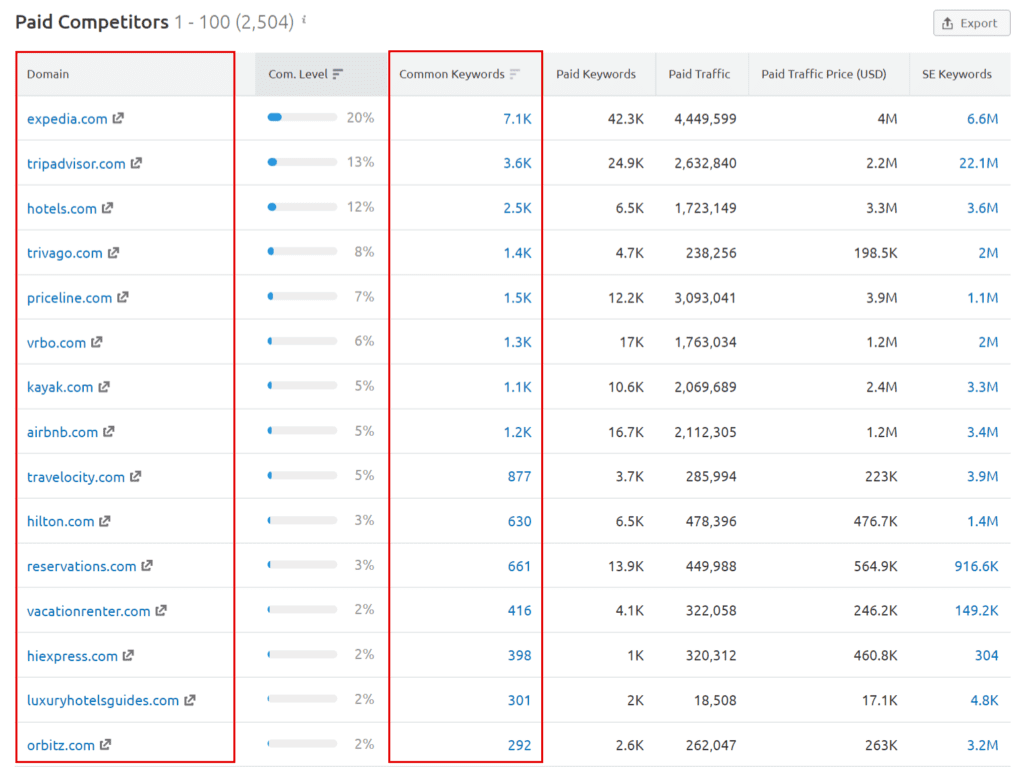
Points to note:
- Click on the ‘Competitors’ tab and you will be able to see the list of competitors for your competitor.
- This tool helps you to expand your competitor analysis exercise by identifying more rival brands that might be bidding on the same keywords as you.
- Check the ‘Common Keywords’ column to get an understanding of the extent of competition.
- You can view the advertising stats of each competitor by clicking on their domain name.
Try it Free: Advertising Competitor Analysis Toolkit
Trying out what you have read about just now, will help you analyze the impact this toolkit can have on your business. If you really wish to beat your competitors and stay ahead in business, do not waste your time procrastinating. Experience the tools while the ideas are fresh in your mind.
If you have just 10 competitors to examine, getting all these competitive analysis data about their ads might take you hours and even days, but with SEMrush you can have all that information in a matter of minutes. You can sort the results by the Cost per Click (CPC), common keyword, etc. to collect the required information. This research will help you collect a significant amount of information about your competitor’s advertising strategies. Based on these insights, you can plan your Google Ads campaigns.
Example Use Case:
Say you are having a Christmas or New Year sale on your website and you want to figure out how to promote your offer via Google Ads. You can do a competitor ads analysis to understand how they might be promoting their offers for New Year. With help of the competitive analysis using SEMrush, you will be able to find out your competitor’s ad copies, keywords and landing pages. You will be able to click into their promotional pages and see if they are giving out any special offers so that you can do something better and beat them.

Free Course. 36 lessons. 5 hours
Free Course: PPC Fundamentals Course with Joel Bondorowsky
With more than 20 years of experience, Joel has launched advertising campaigns with an aggregate budget numbering hundreds of millions of dollars. He has worked with Wix.com and SimilarWeb to name a few.
Get the opportunity to learn from an industry expert.
8. Display Ads Research: Uncover Banner Ads, Pages and Placements
You can use Display Advertising to increase your exposure beyond search terms and gain more visibility for your marketing message. The challenge you might face is figuring out the right type of banners and beneficial placements to show your ads on. This is what SEMrush Display Advertising competitor analysis can help you with.
With help of the Display Advertising research tool you would be able to see which HTML or banner images your competitors are using for their campaigns, landing pages associated with each ad and even which websites their display ads are being published on. You will be able to find out the type of messaging your competitors are using in their banner images to attract your target audience or what offers they have put on their landing pages.
You can learn about your rivals’ advertising strategy, where they are collecting their target audience from and what they are doing differently on their landing pages to get sales or generate leads. Based on this information, you can build your display advertising strategy without having to waste time, money and effort in determining the right type of ads that can work for your niche or a specific season/event-based campaign.
This is how you uncover your competitors’ display advertising data:
- Login to your SEMRush account.
- From the drop-down menu on the top left select ‘Advertising Toolkit’
- Then click on ‘Display Advertising’ from the vertical menu on the left.
- Type the domain name of your competitor in the search bar and click ‘Explore Now’.
- SEMrush will almost instantly show you the banner images they have used for their display advertising campaigns, the keywords and the websites that your competitor’s display ads are being published on.
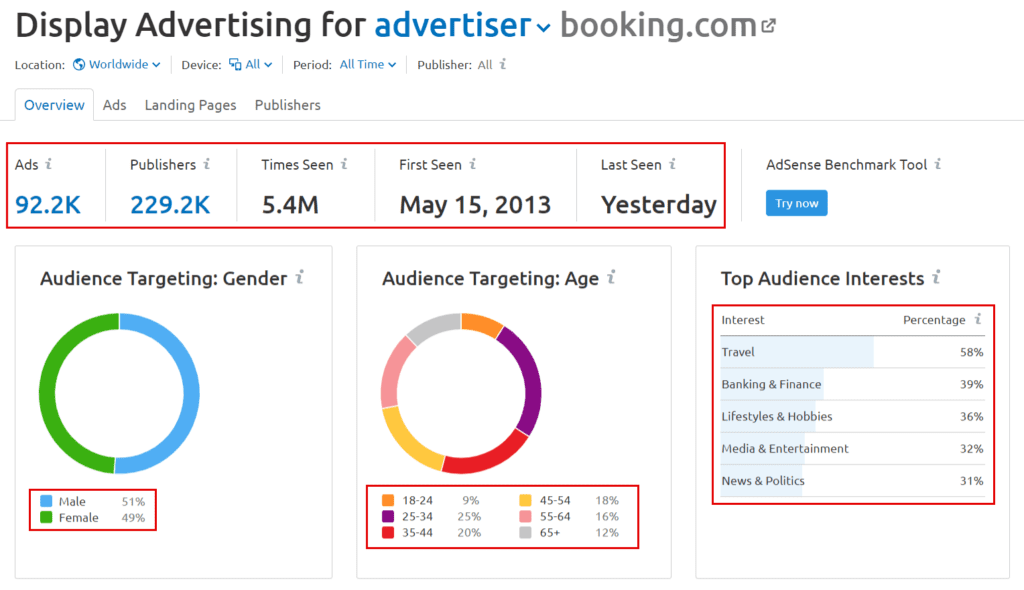
Points to note:
- When you search with the domain name you get an overview of the number of Ads, publishers and various demographic data.
- From up to you can also select whether you want to see the Worldwide data or country-specific data.
- And also drill down the data based on the devices on which the ads were displayed.

Points to note:
- Right below the ad stats snapshot you get this view of different types of banner ads.
- You can toggle the tabs to see their Display Ads based on Image, HTML or Textual Ad.
- Click on ‘View all image ads’ to see the full list of ads published by this competitor.
Try it Free: Display Ads Competitor Analysis Tool
Find out what your competitors are up to, see the Display Advertising competitor research tool in action. Use the tool to find out what latest offers your competitors are promoting, how much they are investing in ads and how they are generating more sales for their products or services.
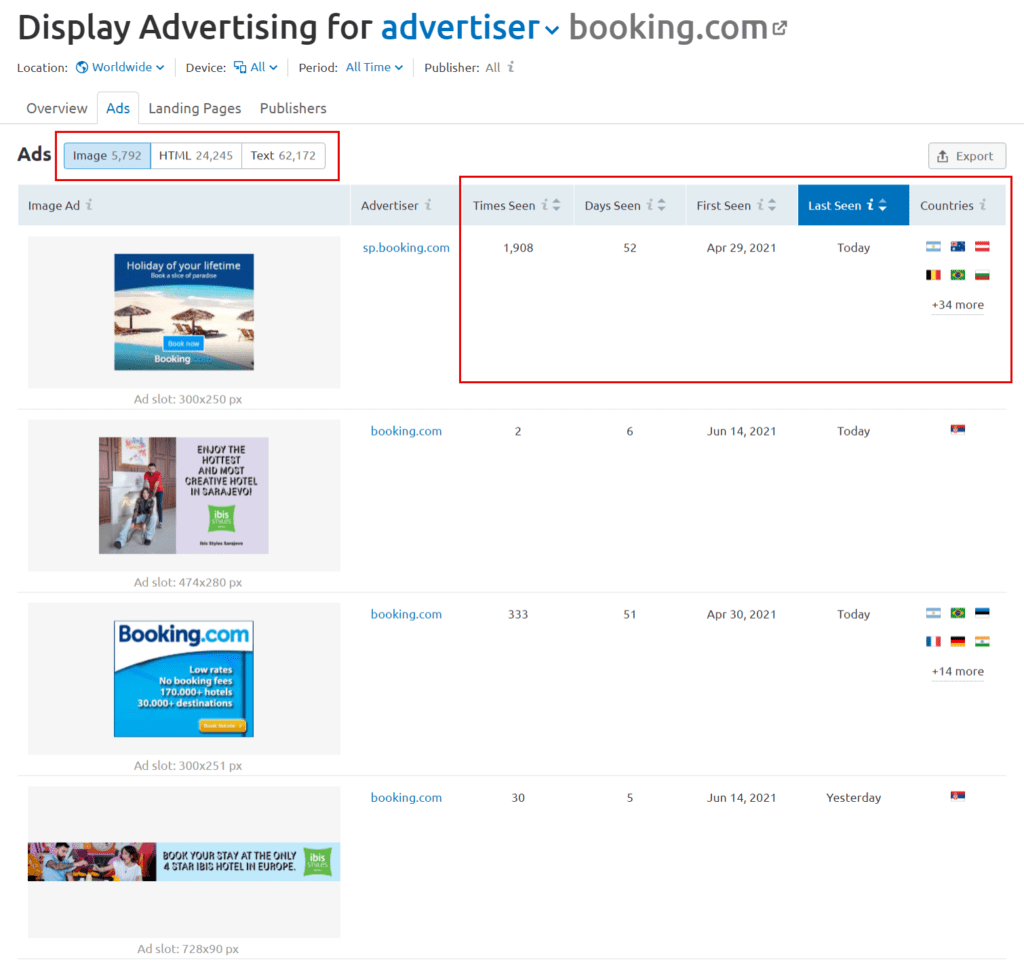
Points to note:
- Click on the ‘Ads’ tab to view all the display ads published by the competitor.
- You can toggle between different types of ads by selecting any of the tabs: Image, HTML and Text
- You can hover on top of an ad to view it in actual size.
- Against each ad, you will find details associated with it.

Points to note:
- Click on the ‘Landing Pages’ tab to view the web pages that are being advertised by the competitor.
- The tool shows you how many ads each landing page is associated with to give you an idea if your competitors are investing more in a specific offer.
- You can use the search box to find landing pages related to specific seasonal terms like, ‘holiday sale’, ‘new year sale’ etc. and find out if they are running any special offers.
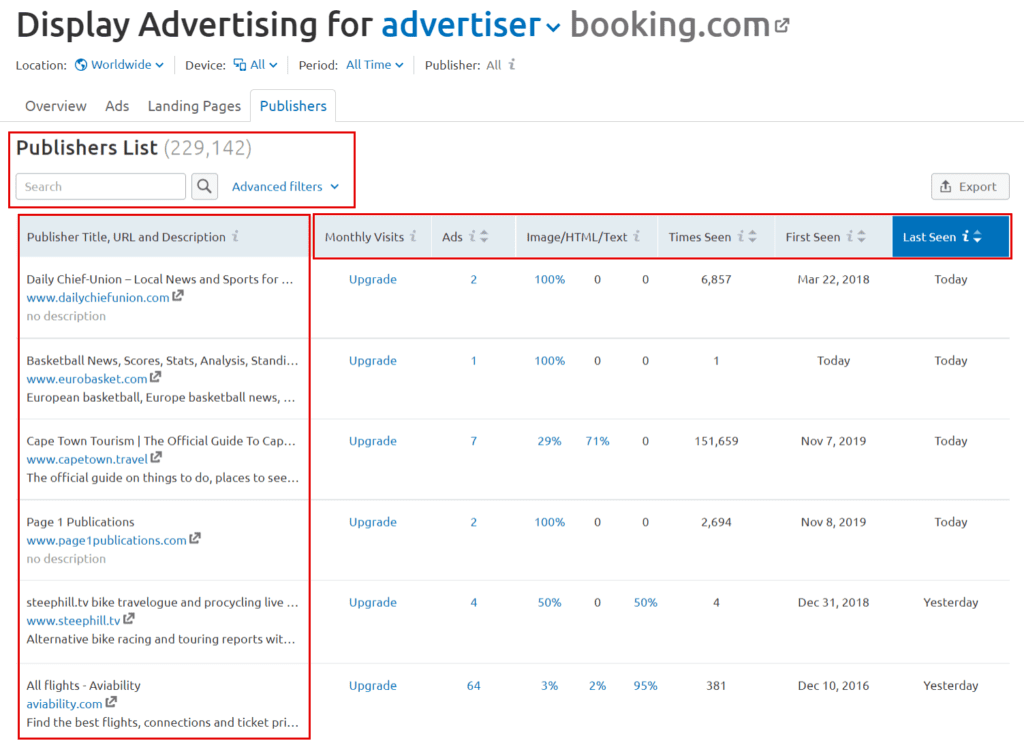
Points to note:
- Now when you click on the ‘Publishers’ tab you get to see the websites on which your competitor has published their ads. Use this data to find out websites that have high volume of traffic and strong relevancy with your product or offer.
- Use the search box to find publishers by specific feature or category like ‘coupons’, ‘travel’, ‘real estate’ etc.
- Use the columns on the table to sort based on different values and find the information required for your display ads campaign.
Equipped with this data you would be able to eliminate any guesswork and precisely plan what ads you need to publish, what type of landing pages to build and most importantly which websites to show your ads on. The Display Advertising research gives you competitive intelligence data so that you can make informed decisions and have more control over the outcome, thus getting a better return on your ad spend.
Read more: Competitor Display Ads Research
One of the biggest advantages of Display Advertising over Search Advertising is that you can reach a much larger audience at a far lower Cost per Click (CPC). But on the downside, if you are not being careful about your targeting you may end up wasting your ad budget by showing your ads to a ton of people who are not interested in your product or service. That’s why choosing publishers carefully is so important.
Pro tip: Importance of Publisher Research
For the success of your Display Advertising campaigns, your ad publishers must be relevant to your ads as it will impact your Click Through Rate (CTR) and conversion. The publisher must also have a high volume of traffic otherwise your ad will not be shown enough and you will not get enough sales. Figuring this out via a live campaign on Google Ads might take weeks or months of testing along with a lot of budget consumption. Whereas using the SEMrush Display Advertising research tool you can find the best publishers within minutes, making your work faster while saving costs.
9. Social Media Tracker: Monitor your Competitor’s Social Activity
When you think of promoting your brand online, social media is not something you can leave behind. You need to keep in mind that when you post something on social media it’s highly likely that your message would be shown to a similar audience as your competitor’s. Use this tool to examine if your competitor’s posts are getting better engagement than yours. Based on this data you would be able to find out if your social media content needs to be updated. If your social media posts are not getting enough interactions as your competitors then clearly there’s room for improvement.
With the Social Media Tracker module, you can monitor your competitors’ social media performance. You will be able to compare your social accounts with your competitors based on their audience size, engagement rate, and overall activity. You will be able to find out if they are getting better traction with a specific type of post, learn from their success and replicate it for your accounts.
Here’s how you can access the SEMrush Social Media Tracker tool:
- Login to your SEMRush account.
- If you do not have an account yet, you can get a trial account from here.
- From the vertical menu on the left select ‘Social Media.
- Then click on ‘Social Media Tracker’ under the ‘Social Media Dashboard’ section.
- On the page that opens click on ‘Get Started’, a pop-up window will appear. Fill in your domain name, add a project name and click on ‘Create Project’.
- In the next window, you will be asked to connect your social media profiles.
- Once you connect your social profiles, type the domains of your top competitors (up to 20 domains are supported).
That’s it! The tool will return with the reports that display your competitors’ social media performances on the basis of engagement, activity, and audience. From now on you will be able to monitor your engagement rate and compare it with your competitors.

Points to note:
- In this example, Nike.com is the main domain compared with their competitors like Puma and Reebok etc.
- We are examining the social strength of Puma, their followers, no. of posts and engagement rate.
- In the lower half of the screenshot, you would find a snapshot of the posts with the highest engagement rate.
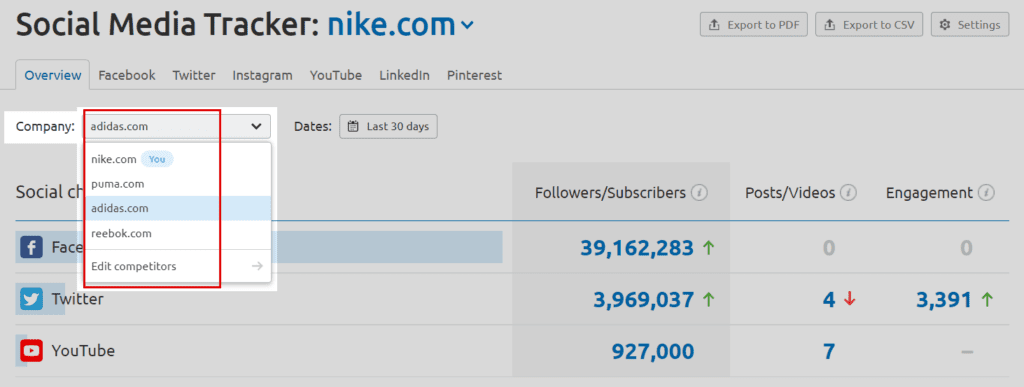
Points to note:
- Use the drop-down menu as shown above to toggle between your competitors and monitor their growth.
- Click on ‘Edit Competitors’ to add, remove or update your competitors.

Points to note:
- The tool also provides you with an option to compare the social profiles of multiple brands side by side.
- This gives you an idea of which of your competitors are growing fast and you need to keep an eye on them.
- Use the social media checkboxes to view their audience strength on specific networks.
Try it Free: Competitor Social Media Analysis Tool
Start your journey to social media dominance. Track performance of your competitors, learn from their best performing posts and figure out what drives engagement for them.

Points to note:
- Use the first box marked in red to toggle between Audience, Activity and Engagement.
- In the table below you can compare the engagement rate and growth of your competitors.
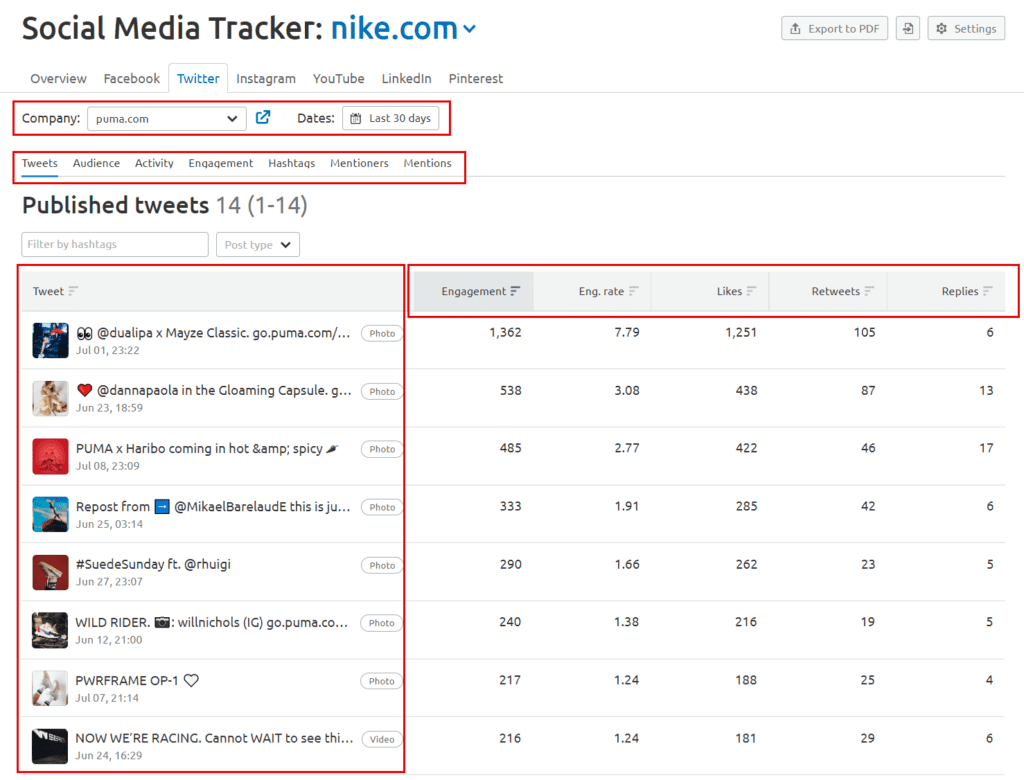
Points to note:
- Click on the Twitter tab to view the performance of a specific competitor on Twitter and so forth.
- From the first red box select the competitor and the date range from which you wish to view the data.
- You can also select whether you wish to view the Tweets, Activity, Engagement and Hashtags.
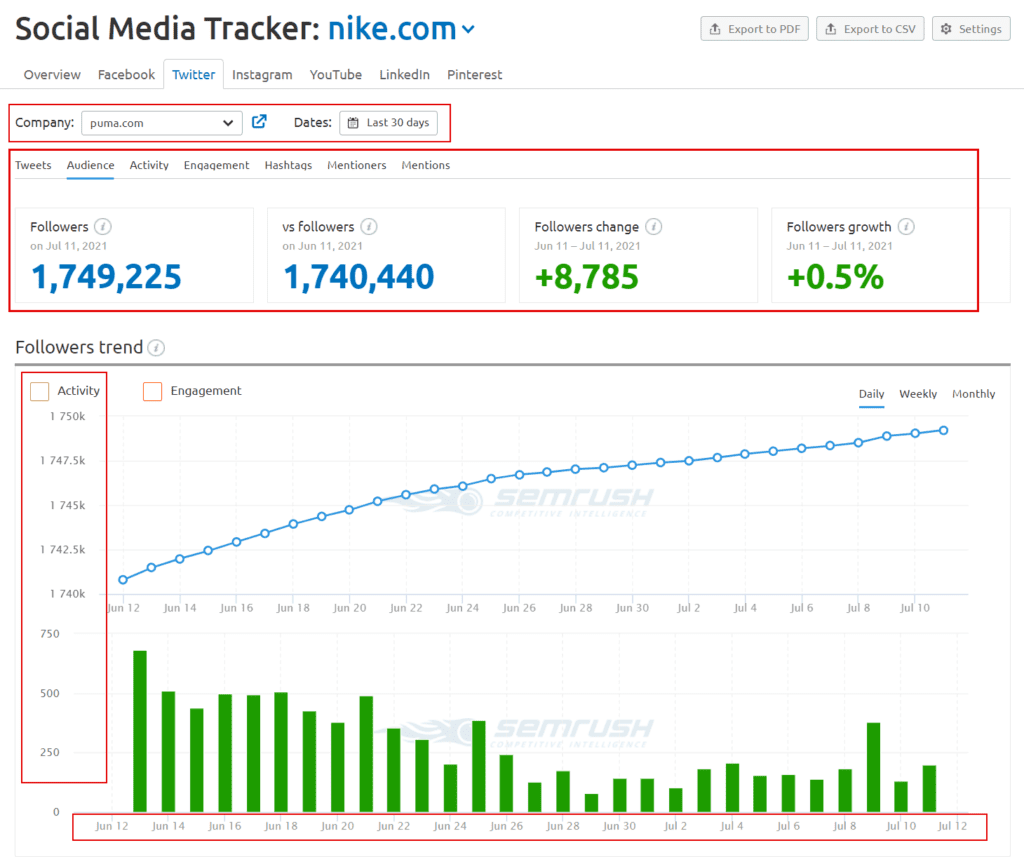
Points to note:
- When you click on ‘Audience’ the tool gives you a visual representation of the growth of the competitor over the selected time period.
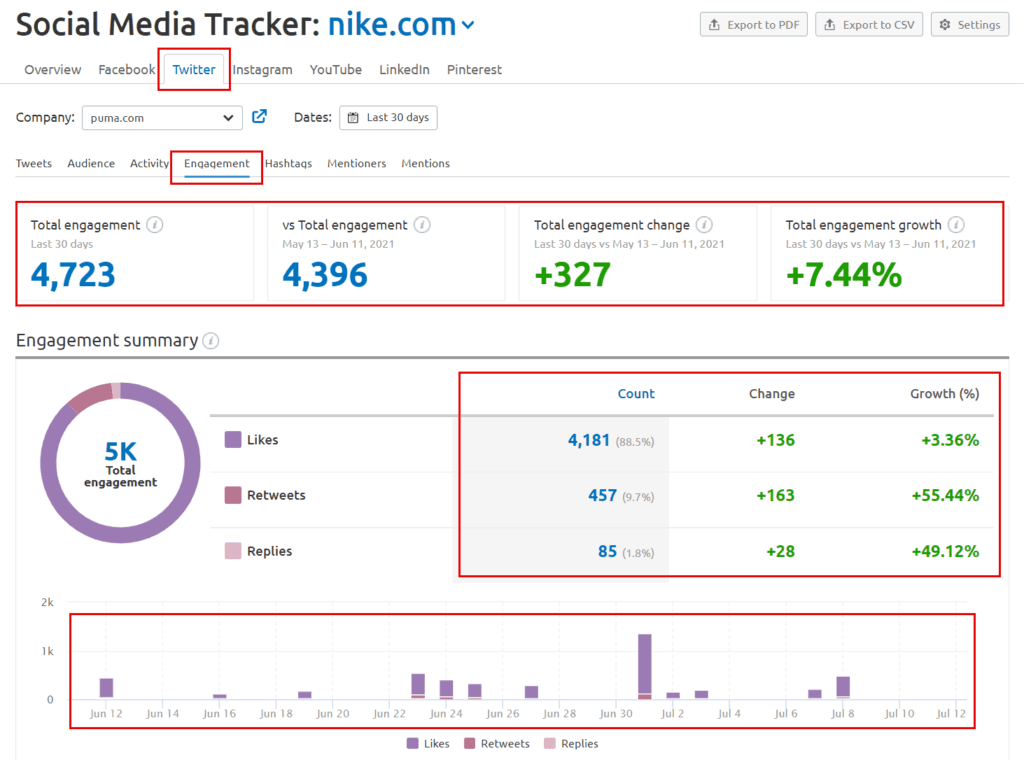
Points to note:
- Click on the ‘Engagement’ tab to view the performance of the competitor in terms of engagement rate.
Download Free: Social Media Marketing eBooks
With help of the Social Media Tracker tool, you will get an overview of your competitor’s performance on different social networking sites. The tool reveals your competitors’ social accounts with the highest engagement and the largest number of followers. You will find the “Top Content” tab just below these metrics. Click on it to find the most engaging posts from your competitors.
The image or perception of a brand on social media can significantly influence buyer decisions and may have a visible impact on a company’s growth. On social media, whether you are a large corporation or a local shop it comes down to your engagement rate compared to your competitors. Therefore it’s critical for you to keep an eye on your competitor’s social media activity so that you are not left behind.
Read more: Social Media Marketing Tactics
10. Brand Monitoring: Test Branding Impact of your Competitors
The Brand Monitoring toolkit from SEMrush helps you monitor the mentions of your competitors from across the web. Be it on any forum or social media, you will be able to keep track of where they are being mentioned. You can use the tool to identify influencers who have mentioned your competitors on social channels. It also gives you the opportunity to deal with any negative mentions of your brand.
The tool can be configured to show you all the websites that have mentioned your rival’s brand names or phrases related to their products/services. Based on this information, you can contact these websites and work with them to create a mention for yourself and link to your website.
Here’s how you can configure the SEMrush Brand Monitoring tool:
- Login to your SEMRush account.
- From the vertical menu on the left select ‘Content Marketing’.
- Then under ‘Content Marketing Dashboard’ select ‘Brand Monitoring’
- On the page that appears fill in the ‘Brand Name’ and ‘Domain Name’ and hit Set Up.
- Now a pop-up will appear in which you would be able to mention the keywords to include and exclude from the search.
- You would also be able to select the Country from which the results are required to be shown. Note that the number of countries you get to add to the list depends on your SEMRush subscription.
- Finally, you can click the check-box to receive email reports about your brand mention. You can set the updates to be sent daily, weekly or monthly and also select the specific time at which you would like to receive the updates.
- Once done click ‘Start Tracking’ and you are all set.
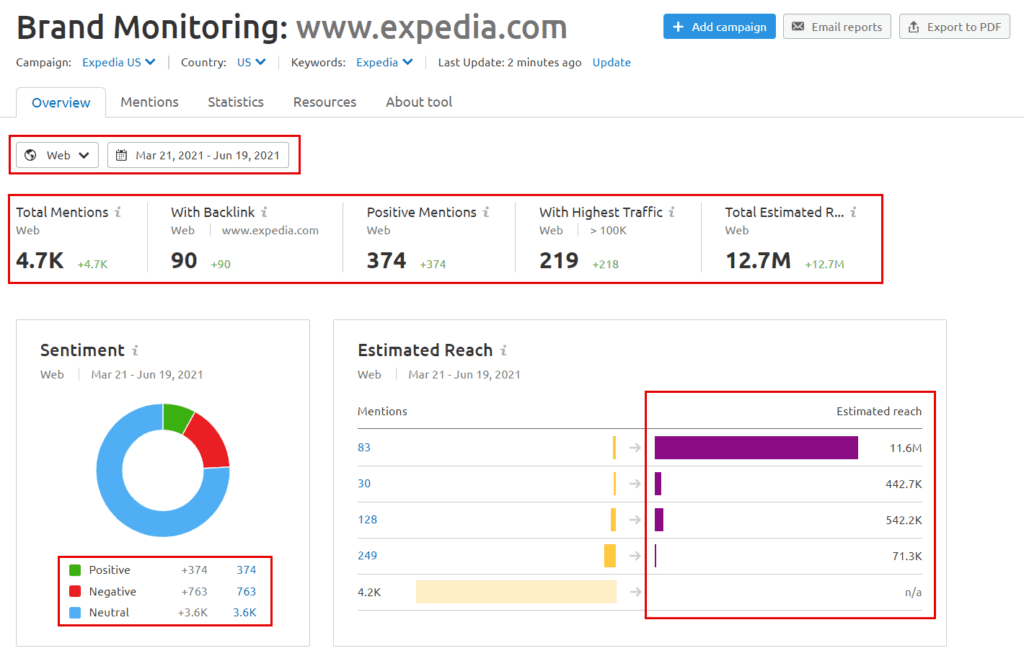
Points to note:
- In this example, we have configured the tool to monitor mentions of expedia.com
- Select from where you want to collect mentions and the date range.
- In the box below you will find out total mentions, backlinks, positive mentions and high traffic websites.
- You also see a sentiment breakdown and an estimate of their brand reach.
Try it Free: Brand Monitoring Tool
Find out where your competitor’s brand is getting mentioned, keep track of their management changes and big moves. Take informed decisions to stay ahead in the market.

Points to note:
- Then the tool shows you top domains and backlinks so that you can upgrade your visibility.
- Find out how many high traffic domains have mentioned your competitor to estimate their reach.
- You also see the Authority Score of domains that have mentioned your competitor.

Points to note:
- Click on the ‘Mentions’ tab to view a list of top occurrences of your competitor across the web.
- You can select a language or search through the mentions with a specific term.
- As shown in the screenshot above, you will be able to monitor different activities like mentioned in forums and blogs, news channels, stock performance and even customer complaints.
Pro tip: Monitoring your own brand
If you are going to invest time and money in promoting your brand online you need to be vigilant about your brand’s reputation as well. You need to constantly be on the lookout for any negative messaging so that you can counter them. In case you find a positive mention from a really popular source then you can promote those mentions to showcase your strength. Plus, Google search algorithms take into account the amount and quality of brand mentions to determine the authority of a website. In summary, your brand mention is not something you can take lightly.
A negative mention on a reputed website can lead to a decline in the trust of prospective customers and affect your sales. Now it would not be possible to scan through the entire web to find such mentions of your brand, even with help of Google you would have to spend a ton of time finding all your mentions. In fact, Google will display only the ones that they have indexed, and based on ranking factors you might not find all. This means you are going to need a tool like this to find out your brand mentions and take action.
Read more: Brand Uplift Strategies
11. Reporting: Benchmarking for Strategic Growth
With any marketing strategy, it’s not enough to just push out campaigns, you should be able to also track your results and record them to assess your progress. You might also want to showcase your achievements to the management team. In any such scenario you need not scramble for software to help you aggregate your performance data into a well-structured report, neither do you need to manually create reports and end up wasting your time. You can rely on the built-in SEMrush Report Creation module to instantly build and send out custom reports from the platform itself.
Use this tool to keep track of your progress in comparison to your competitors and grow your business. If you just go along with your routine tasks without monitoring how much your performance has moved up or down you may risk falling behind your competition. With help of the SEMrush report creation tool, you can automate reports and have them emailed to respective stakeholders on a regular interval so that you have adequate data to optimize your campaigns.
To build your performance reports, do the following:
- Login to your SEMRush account.
- From the vertical menu on the left scroll down to the section named ‘Management’.
- Then click on ‘My Reports’ and on the page click ‘Create Report’
- This will open up the report builder interface where you will be able to select from over 200 drag and drop widgets to instantly build engaging reports.
- Once you have finished building your report you can choose from either or all of these options to extract the report:
- Download the report instantly
- Send it to a couple of recipients
- Or schedule the report on a Daily, Weekly or Monthly basis
Try it Free: Report Building Tool
Measure your performance, compare with your competitors, identify areas of improvement and build successful strategies for consistent growth.
You can have your team generate regular reports to monitor the progress of your campaign and make necessary adjustments. SEMrush makes it extremely easy to create reports with pre-existing templates that you can set up within minutes with just a few clicks.
The Reports module also offers a drag and drop functionality to build custom reports as per your requirement. You also get an option to schedule your reports, which means SEMrush will automatically build the report at the scheduled time interval and send it out to the preset recipients. Based on the template structure you create SEMrush will fill in the updated data for the week or the month and automatically send you an update.
For more details on how to build reports and use them to gain insights for your campaigns, you may check out their blogs and KB articles mentioned below.
Read more: SEMrush Report Builder
So, what can you find with Digital Marketing Competitor Analysis?
When it comes to competitor analysis in digital marketing, there is a lot to uncover. With SEMrush you can analyze their SEO activity and their Google Ad campaigns (Search & Display) along with their social media performance. You can check what keywords your competitors are bidding on and what text ads they have published on Google search. If they are advertising on the Google display network then you will be able to see exactly what banners they have posted, what sizes, which websites they are publishing their ads on, which keywords are working for them and which ones are not.
SEMrush can even show you from which domains your competitors are getting quality backlinks but you are not so that you can build the missing backlinks and improve your SEO rankings. All of this information can help you turn the game in your favour. SEMrush helps you accumulate competitor analysis data in the form of valuable marketing insights that can help you derive calculated decisions to fuel your growth.
If you can try out the tools while going through this blog you would have a better understanding of its impact. If you are driven by an urge to grow your business fast and wish to outdo your competitors then it’s important that you understand how you can use each module to extract beneficial information and gain competitive advantage.
Conclusion
It is quite evident that having a tool like SEMrush can significantly contribute to your competitor analysis efforts. It can not only help you grow your business faster but also save costs. You do not have to waste hours digging through the web to find relevant information, you can have access to all the key data points in a matter of minutes. It helps you save costs in the form of work hours being saved from manually collecting data. SEMrush also makes reporting easy for you with ready-to-go and automated reports.
Irrespective of whether you are trying to perform SEO competitor analysis, competitor keyword research, competitor backlink analysis or understanding where they are investing their Advertising budget, we have shown you how you can use SEMrush to find that information. The tool helps you figure out your rivals’ strengths and weaknesses without the need to spend hours conducting competitor research. In one click, you can get a comprehensive report about competitors’ marketing landscape.
Our Objective with this blog was to show you techniques to help you compete with your rivals and gain a competitive advantage to increase your traffic, get more sales and thus grow your business. We hope we have succeeded in providing you with the necessary information to help you take your research forward. If you have any queries on this topic please feel free to reach us.
So, do not waste your time waiting, grab your SEMRush subscription right away and uncover strategies to take lead in the market and grow your business.
Frequently Asked Questions (FAQ)
Competitor analysis is the process of identifying your direct and indirect competitors, evaluating their strengths and weaknesses, learning from them and making improvements to your own strategy based on your findings. When it comes to digital marketing it would involve uncovering the keywords, text ads, banner ads and landing pages used by your competitors. In this blog, we will also look into how to identify your backlink competitors as part of our SEO competitive analysis.
You can manually observe your competitors but it would be impossible to uncover all aspects of their digital marketing strategies (like keywords, banner ads, backlinks etc.). It will take away a lot of your time and effort with probably no results. Therefore, to be able to conduct competitor analysis efficiently and collect enough valuable information you will need a powerful and reliable tool. That’s why we have used SEMrush to demonstrate 11 techniques to perform competitor analysis.
We have been using SEMrush for a couple of years to optimize digital outreach for our clients and we have received tremendous results. So it’s something we can vouch for and be confident while sharing with our readers.
Because if you are not paying attention to your competitors you might be missing out on a lot of valuable insights. Your rivals might spend a ton of resources each year on crafting the perfect marketing strategy that can work wonders for them, and being able to get a sneak peek of their marketing strategies ethically and learn from their success can be priceless. It will help you identify the right strategy with minimal effort and at much lower costs.
If you choose to stay in one place and refuse to adapt to changing marketing trends relying on your regular methods then you might be heading towards some shocking realizations. Your marketing strategies need to adapt continuously, adjusting to changing trends to keep your business a mark ahead of your competition.
With SEMrush you can find your competitors using 3 different techniques. Please click on the floating Table of the Content icon on the right side of the screen. Scroll to the top and click point 1 ‘Accurately Identify Your Competitors for Analysis‘. The 3 categories in which you can find your competitors are:
a. Competitors in Google Advertising
b. Organic Search Competitors
c. Backlink Competitors
Yes, you can. There are 2 main approaches you can take. You can either use the Advertising Research tool to find the keywords used by your competitors in Google Ads. Or you can use the Organic Research tool to find out keywords your competitors are optimizing their website for.
– To help you decide where to place your ads so that you can precisely reach your target audience. Get quality traffic and get better conversions for your budget, thus improving your Return on Advertising Spend (ROAS).
– Identify which type of banner images your target audience find attractive so that you can eliminate the hit and trial phase and get straight to building a healthy flow of targeted customers to your website.
– Watch and learn from the landing pages used by your competitors. See how they are selling the same product as you, are they trying some new tricks or have they got some discount offers to entice their viewers.
– Learn from their mistakes so that you can avoid those and save your money from being wasted.
With the Topic Research tool, you will be able to identify which topics related to your search term are in demand. The tool will also provide you with content ideas, headings and additional topics or subtopics related to your main search term so that you can build a strong content structure for your website. Having really well written high-quality content can entice other people to link back to your website thus earning you organic backlinks for SEO. This will also assist you in positioning your brand as a thought leader.
Here’s what the tool helps you with:
a. Collect multiple content ideas around a specific topic
b. Discover which content pieces your competitors are ranking for.
c. Choose from hundreds of topics
d. Get sub-headings for your content
e. Get a list of the most frequently asked questions
f. Generate high-quality and best content ideas to rank in search results
Because your competitors might be bidding on some keywords that are working for them to get quality traffic to their websites at a lower cost and are selling their products. So how would you know which keywords your competitors are bidding on to reach your target audience and drive their sales, what type of ads are getting them clicks and which landing pages are they sending their traffic to? With SEMrush you can just type in your competitor’s domain in the Advertising Research tool and have all the data in front of you almost instantly.


